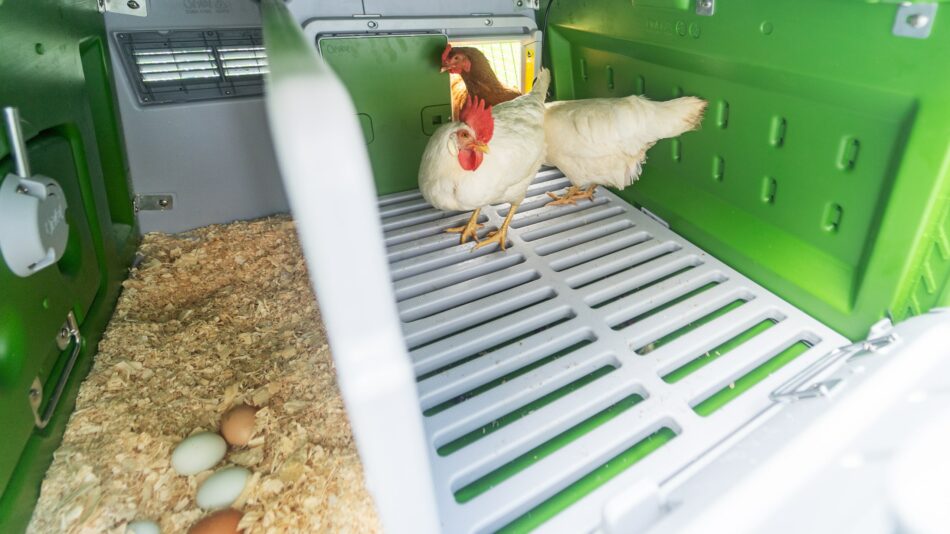
Chicken roosts are an essential part of a flock’s setup. They’re simple in their concept, but chicken roosts can prove difficult to perfect in their construction and placement. Omlet has taken the guesswork out of the perfect chicken roost, and we’ve incorporated them in all of our chicken coops. Read on to see how to help your hens make the most of roosting time for their well-deserved beauty rest.
What is a chicken roost?
You can think of your chickens’ roost as their bed — and like a mattress, a roost can make or break a good night’s rest. Chickens will spend anywhere from 8-12 hours roosting, depending on the amount of daylight. When the sun starts to set, your hens will instinctively head to their cozy chicken coop.
Setting up the perfect roost for your chickens
The perfect place for chickens to go to roost is:
- Set up above ground level
- Separate from egg-laying areas
- Shielded from the elements
- Safe from chicken predators
Chicken roosts should be constructed of easy-to-clean materials, and should be comfortable for your hens’ feet. Traditionally, roosts have been either round or rectangular bars that are small enough around for chickens’ feet to grasp. But, since chickens squat down to cover their feet when they roost, these bars have them performing a balancing act all night long. A much better alternative is a flat, textured surface for them to get comfortable on.
Creating an ideal roosting area is a vital part of how to take care of your chickens. This secluded, comfortable area should make your hens feel safe and protected all night long. Quality sleep contributes to your flock’s overall health and well-being, making their roosting area a fundamental element of their setup.
Why do chickens roost?
A “roost” is both a verb and a noun: chickens roost at night in their roosts. Roosts are where birds congregate in order to sleep, and their biological clock tells them when to roost. Some birds roost on the ground, but many species of birds, both wild and domestic, seek roosting places that are above ground level. Chickens are part of the elevated-roosting group of birds.
Protection from predators
Being elevated while sleeping makes hens feel safer from chicken predators and the weather. In the wild, many birds roost in trees that offer a canopy of shelter from the elements. Similarly, your chickens will seek a place that is both elevated and shielded from the wind, rain, and snow.
Pecking order at night
When night begins to fall, your hens will begin to head in to roost in their coop. If you observe the order in which they turn in, it’s common for hens at the top of the chicken pecking order to claim their spot in the roost first, and the rest will follow suit down to the lowest-ranking hen. In an established flock, the top-ranking hens will make sure every flock member has a place in the roost.
Keeping your hens safe whilst roosting
By the time the last hen has turned in for the night, it will be past sunset. This is when predators are most active, which is why hens instinctively roost before nightfall. To add an additional layer of protection, an automatic chicken coop door can be installed on your hens’ house to make sure everyone is tucked in safely after dark.
Difference between chicken perches & roosts
Not to be confused with a roosting area, chicken perches are bars set up inside of your flock’s run to give them space to climb and exercise. Many hens enjoy being above ground level at various times throughout the day to observe their surroundings. Hens will flap, fly, or hop their way up to their perches, which help to strengthen and stretch their wings.
Chicken perches like the PoleTree Customizable Chicken Perch or the Freestanding Chicken Perch are designed for play and enrichment, or maybe the occasional afternoon nap in the sun – but not for overnight sleep. Roosting overnight on a chicken perch in the run leaves your hens exposed to the elements and at higher risk of encountering predators.
Common chicken roost problems
Many chicken keepers mean well when they set up their flock’s roosting area, but most homemade constructions fall flat when it comes to creating restful roosts. Oftentimes homemade roosting bars or racks:
- Are hard to clean
- Invite mites
- Weaken over time
Any poorly placed, wobbly, or unlevel chicken roosts will be deemed unfit for sleep by your flock. You may also notice older hens avoiding roosts that are too high, as their joints can’t support them when they dismount each morning. Heavier hens may also have trouble flying up to roosts that are too high.
Uncomfortable, unsafe, or cramped roosts can lead to a chicken not going to their coop at night. Instead, your hens may find their roost in nesting boxes or on perches out in their run. This behavior can quickly become frustrating and dangerous, and should be addressed as soon as possible.
How much roosting space per chicken?
Another potential problem with homemade roosts is inadequate spacing. Sometimes there’s just not enough room for the last hen or two to find a comfortable spot in the roost at night. On the flip side, if there’s too much space, hens may feel vulnerable. This is a problem particularly in the winter months, as hens will huddle together for warmth overnight.
Different chicken breeds have varying space requirements, but as a general rule, you should aim to provide approximately 8-12 inches of space on the roost per hen. Omlet’s large chicken coop has a roosting area that can accommodate up to 10 hens comfortably.
Best chicken roosting bar material
There are different types of roosting bars and racks. We’ve outlined the most common materials, and the pros and cons of each.
Wooden roosts
Wood is the most traditional material for constructing chicken roosts. It’s affordable, easy for chickens to grab onto, and readily available. However, wood has its fair share of disadvantages as well.
Cons:
- Absorbs moisture and odors, allowing bacteria to breed
- Harbors mites and other insects
- Can splinter off into your hens’ feet
- Warps, rots, and deteriorates over time
- Hard to clean
Pros:
- Affordable
- Readily available
- Cut and placed easily
For all of its popularity, wooden roosts are not the most practical solution. There is a lot of maintenance and upkeep involved in wooden roosts, and most chicken keepers would do well to avoid them.
Metal roosts
At a cursory glance, metal roosts may look appealing. They’re easy to clean, long-lasting, and don’t require much upkeep. But even with these advantages, the biggest drawbacks involve your beloved hens.
Cons:
- Slippery and hard for hens’ feet to grasp
- Easily affected by temperature – they can be burning hot or freezing cold to the touch
- Expensive
- Difficult to adjust or cut to size
Pros:
- Long-lasting
- Easy to clean
As you can see, metal roosting bars and racks can be very dangerous for your hens. In cold weather, chickens can actually become frozen to metal roosts, and in hot weather, the metal can burn your hens’ feet. Their longevity might be appealing, but it isn’t worth the risk to your hens. There’s an even better, long-lasting solution.
Plastic roosts
Plastic has the best of both worlds: easy to maintain and safe for your hens. Here are the pros and cons of plastic:
Pros:
- Easy to clean with a pressure washer or sponge
- Doesn’t absorb moisture
- Not hospitable to mites and insects
- Easy for your hens’ feet to grasp
- Is not easily influenced by the temperature
- Long-lasting and does not require routine maintenance
While plastic roosts may be hard to make yourself, Omlet has perfected the plastic roosting rack that is included in all of our chicken coops. The ergonomic design fits perfectly in the coop with a slightly textured surface to give your hens’ feet purchase on the smooth material. And, being made of heavy-duty plastic, your Omlet setup will be the only one you’ll ever need to buy.
Cons:
- Difficult to cut to size
- Not readily available (apart from an Eglu chicken coop)
Chicken roost ideas
The ideal chicken roost will be:
- 3-4 feet off of the ground
- Made of an easy-to-clean, comfortable material
- Large enough to accommodate your flock, but small enough to make them comfortable
- Separated from their nesting boxes
This particular setup may prove to be difficult to design within an existing coop. Plastic is extremely durable, but difficult to cut with common tools – not to mention hard to come by. So what’s a chicken keeper to do when pursuing the perfect chicken roost? Thankfully, Omlet has the solution to this conundrum.
Creating the ideal chicken roost with Omlet
The Eglu Cube has a divider that can be closed to prevent hens from roosting in the nesting area, and has designated doors for both the roosting area and nest box. Additionally, the Eglu Cube’s roosting area has:
- A roosting rack constructed of heavy-duty plastic with a textured overlay to help your hens grip the surface
- Small openings for droppings to pass through to the tray below, which also offers small footholds for your chickens
- A large, flat area perfect for your hens to hunker down for the night
The fully enclosed Eglu Cube makes it a formidable fortress for your flock during their most vulnerable times. With the dual-insulated walls and ample ventilation, your chickens will never be more comfortable.
The other two chicken coops from Omlet are:
Both of these coops are for smaller flocks of 2-6 hens, and include the same style of roosting rack as the Eglu Cube. In addition to a plastic chicken roost, both coops also feature:
- Dual insulated walls and ample ventilation
- The ability to add on wheels and handles to convert them into mobile chicken coops
- Easy-to-clean interior components that can all be pressure washed or wiped down
All of our chicken coops help foster your flock’s natural behaviors and habits, including a comfortable and secure roosting routine.
Chicken care with Omlet
From roostime to playtime, give your chickens the best when you choose Omlet for all of your flock-raising needs. All of our products have been rigorously tested by both our team of experts and through daily experience from our customers. Our dynamic chicken tractors and unique toys like the Chicken Swing are sure to be a delight to both flocks and their raisers.
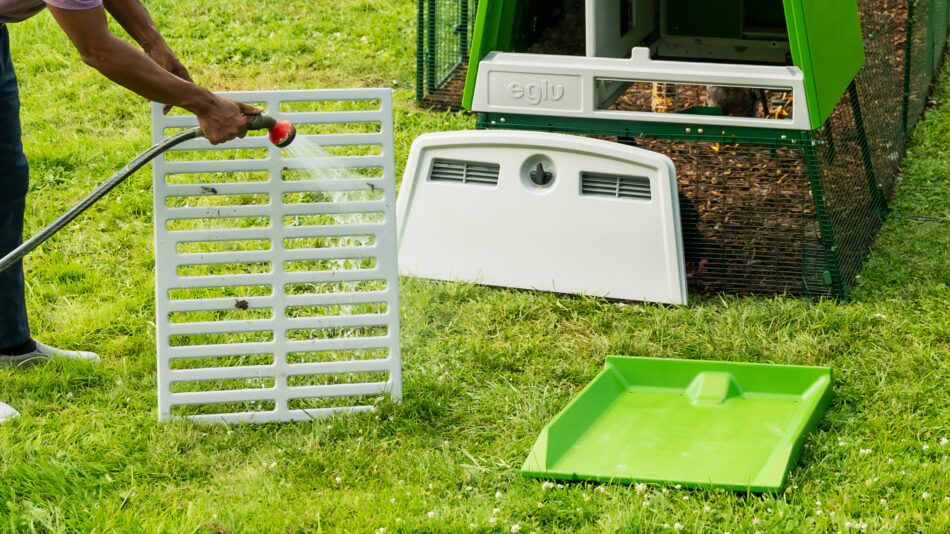

This entry was posted in Chickens

Have you thought about raising chicks this fall? There are many advantages to brooding chicks in the fall versus the spring, but it’s important to choose the right breed for your climate and weather patterns. We’ll help you in your journey to find the right breed of chick for fall, and offer some tips to help your young hens thrive.
Raising chicks in fall 101
Fall is a great time to raise chicks. The weather is mild, and chicks that grow out over the fall and winter will be ready to lay eggs in the spring. Some other reasons to raise chicks in the fall include:
- Perfect temperatures for putting your chicken coop together
- Less vegetation and insects to distract your young hens from getting used to their regular diet
- Shorter days ensure your growing chicks get used to their roost-to-rise schedule
The main consideration when raising chicks in the fall is to make sure they will be fully feathered by the time cold weather comes. Most chicken breeds will be fully feathered by the time they are 6-12 weeks old, with 12 weeks of age being the best time to move them into their permanent hen house outside.
Fall chicks mean winter pullets
Once your young hens have reached 12 weeks of age, they’re ready to move into their Eglu Cube. At this age, they will be fully feathered and have enough strength to navigate a coop ladder and put themselves to bed when it’s time to roost.
The winter temperatures won’t pose a problem for fully-feathered pullets, but if you live in an area that experiences particularly cold winters, adding Eglu extreme temperature protection will make sure your pullets are at their coziest in sub-freezing conditions. Taking care of your pullets at this stage will be the same as taking care of your chickens during the winter — they may be young, but their fully-feathered frames will serve them well in the months to come.
Why do some chicken breeds do better in winter?
Most breeds of chickens fare better in colder weather than in hot, but some breeds are more likely to thrive in cold temperatures. Breeds with short combs and wattles are resistant to frostbite, and heavier breeds have more body heat to insulate them. We’ve listed some of the most cold hardy breeds that will be perfect pullets by the time winter makes its appearance.
Ameraucana
The Ameraucana chicken is a hardy breed that lays colorful eggs. They have pea-combs that are resistant to frostbite, and have a good resistance to cold temperatures.
Cochin
Cochins are very fluffy, which gives them an edge in the colder temperatures. Their legs are also covered in feathers, which helps insulate them from windchill. But their owners should take care that their leg feathers don’t get wet — damp feet during winter temperatures can be dangerous.
Dominique
The Dominique chicken has a small comb and large body, making it well equipped for the cold. Their dense feathers keep them well insulated, and their “barred” (striped) pattern is a stunning addition to a flock.
Faverolle
Faverolles are another fluffy breed. They have feathers on their face called “muffs” and are bearded, meaning they have tufts of feathers under their chins. Their legs are sparsely feathered, offering some protection from the cold. This interesting flock addition also has 5 toes as opposed to the traditional 4.
Sussex
A dual-purpose breed, the Sussex is a larger chicken with dense plumage. They may not have feathers, but their bare legs are covered nicely by their bodies when they roost. They are an overall hardy breed that is adaptable in any season.
Wyandotte
Wyandottes are big and beautiful chickens. Their body mass helps to insulate them, as does their full plumage. They have rose combs that are resistant to frostbite, and are considered to be hardy in most weather conditions. They can be found in a wide variety of colors, and are known to continue their egg production through the winter.
Cold-hardy chickens in summer
Your winter pullets will become spring chickens — and will then experience their first summer. Like all hens, cold hardy breeds need special care during summer months. But, those best suited for cold climates may struggle in the heat more than others.
Chickens release heat through their combs and wattles, so short-combed breeds may overheat more easily. Keep your chickens cool in the summer with lots of water and plenty of shade in their run with weather protection covers for walk in chicken runs. Chickens are amazingly resilient and adaptable, and the vast majority of hens are capable of weathering all of the seasons with the right setup.
Omlet and fall chicks
Our chicken-keeping products will help your fall chicks thrive — and be comfortable and protected in the process. Our Eglu Cube chicken coop will keep your pullets safe and thriving throughout the cooler weather. Extreme temperature jackets add an extra layer of insulation for your future layers — keeping them cozy all winter long in preparation for warmer weather. At Omlet, we’re here to help you and your hens enjoy every season together.


This entry was posted in Chickens
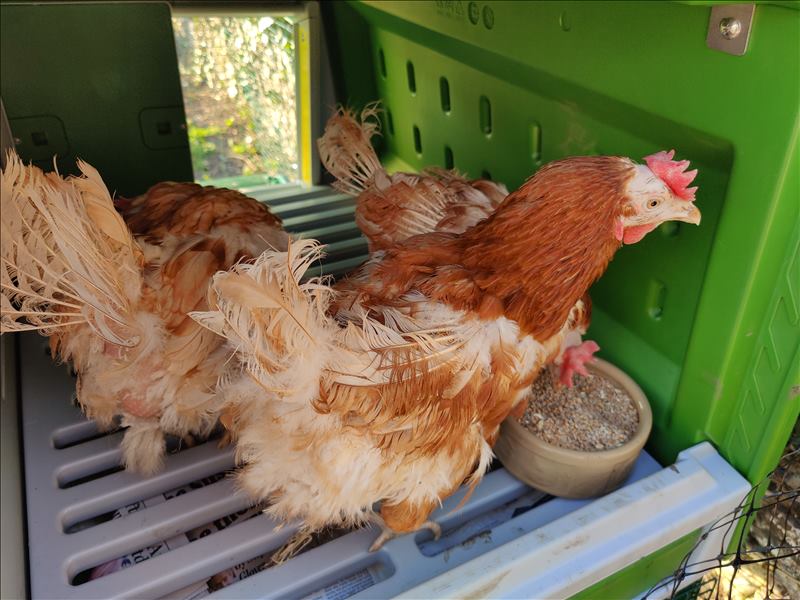
Have you considered rescuing chickens? Whether you’re just starting out with a flock, or growing an established one, adopting hens can be an emotionally rewarding experience. Hens can be in need of rescue for a number of reasons: owner surrender or confiscation, retiring breeding or laying hens, or chickens with special needs – there are chickens in search of their forever homes. We’ll share our 6 top tips for rescuing hens, and show you how Omlet can support them, and you, in the journey.
1. Find the perfect chicken coop
Creating the perfect setup for rescue hens is essential in helping them adjust to their forever home. Hens in need of rescuing may have been confiscated by law enforcement due to neglect or unsuitable living situations or may be leaving a noisy egg production facility. No matter what their story may be, all rescued hens will be in desperate need of a safe place to land.
Having an Eglu Cube chicken coop ready for your hens’ arrival will provide them with peace and comfort from the start. With its elevated design and secluded egg-laying area, hens can find rest in the shade and a secluded place to lay their eggs privately. The attached run offers space to peck at the grass – which may be something rescued hens have never experienced before. The Eglu Cube is also available as a chicken tractor to offer your newly rescued hens fresh patches of grass and a new selection of insects to munch on.
Adding an automatic chicken coop door will help your hens feel even more secure overnight. The gently closing door will tuck them in tight and keep potentially stressful sights and sounds from keeping them awake. And, with the ability to open and close on a light or timed schedule, rescued hens can seize the day at the crack of dawn while you sleep in.
2. Give them plenty of space
Space is not something generally afforded to hens that are coming from less-than-ideal living conditions. Whether they’ve been crowded or caged, your newly rescued hens will appreciate having some room to spread out. And, as their new owner and forever-home-provider, you’ll want to spend time with them in their setup.
Our Walk In Chicken Run gives rescued hens the space they deserve, while giving you the opportunity to spend time with them. The convenient and secure stable-style doors let you access your hens with ease, and the fully-enclosed run keeps your hens safe from predators. The anti-dig skirting helps prevent predators like weasels, raccoons, and foxes from tunneling in, and the roof panels keep aerial predators away from your flock.
Customize their walk in run with chicken perches, the PoleTree customizable chicken perch, or Freestanding Chicken Perch for unparalleled perching opportunities. Perches or chicken toys and the enrichment they provide are probably elements that rescued hens have never encountered before, but are excellent ways to let your new flock members know that they are loved and safe in their new home.
3. Allow them to settle
Depending on their previous living conditions, rescued hens may take longer to settle into their new homes than those raised in ideal situations. At first, they may be distrustful of humans – either from negative experiences or lack of contact. Give them plenty of time to become used to seeing you. With patience and routine, your rescued hens will soon figure out that you mean them no harm.
As tempting as it may be to get to know your new chickens, don’t attempt to handle or pet rescued hens for the first week or two. Chickens make great family pets, but children should be taught how to handle hens properly and to respect their space when needed. Rescued hens will be overwhelmed enough trying to get used to their new surroundings, so incorporating unfamiliar physical contact may be too much for them. Instead, try to sit quietly with your flock while they eat or peck in the grass. Speak softly to them to get them used to your voice. Over time, you can offer treats or scratch grains by hand – just make sure to let your hens come to you.
4. Understand the pecking order
Chickens are social animals that have a hierarchy within their flocks known as the “pecking order.” To new chicken keepers, the act of establishing this pecking order may be confusing or even concerning to witness. To understand the pecking order in your hens, you’ll need to watch them closely when introducing them – both to each other and to a new home. Normal behaviors for chickens establishing a pecking order include:
- Raising the feathers around their neck
- Squaring off with each other through posturing or staring
- Squawking or clucking at each other
- Brief scuffles that include sparring and/or feather pulling
Every flock has a pecking order, which can be challenged periodically even once it’s established. It’s normal to see minor and short-lived disagreements within an established flock, but chickens should be separated from each other if:
- Physical altercations occur more often than once or twice a day for consecutive days
- Bleeding or extreme feather pulling occurs
- Dominate hens are keeping other hens from coming into the coop to roost or lay eggs (even the “top ranking” hens should see that the lowest ranking hens have a safe place to sleep and lay)
- Flock members are keeping others from eating or drinking
5. Keep an eye on their health
If you’re adding rescued hens to your own backyard flock, you’ll want to be absolutely sure they’re healthy first. All new chickens should be quarantined away from your flock for 14 days to make sure they don’t have anything contagious. Consider having a secondary chicken setup such as the Eglu Go chicken coop to quarantine new hens, or to separate ill or fighting flockmates.
Even if your rescued hens are your first flock, you’ll want to give your chickens a health check before releasing them into their setup. Once they’re in their forever home, keep a close eye on them to make sure they are eating, drinking, and acting normally.
The appearance of rescued hens varies, but some common ailments seen in rescued hens include:
- Dull or missing feathers
- Clear, thin discharge from the eyes or nose
- Irregular gait or hesitant to walk much (usually due to being confined in a wire cage – their feet may be sore and their legs weak)
These minor discomforts should resolve within a week or two after eating a nutritious diet. If your hens don’t improve, or get worse, be sure to call your veterinarian.
6. Provide them with the right diet
Feeding your hens a nutrient-dense diet will help them feel and look their best. If they are a laying breed of chicken, be sure to feed them quality laying pellets containing 16-18% protein. Your hens can have feed left out for them all day – even rescued hens that may have been deprived of food will not overeat. It’s also helpful to feed chicken supplements to help hens bounce back from stress. Protein-rich treats like dried mealworms or scratch grains will help hens feel more energized – and are also a great bargaining chip when it comes to winning their trust.
As with any flock, make sure rescued hens have unlimited access to fresh water. Adding a small amount of apple cider vinegar to their water will help boost your hens’ immune system and help them grow healthy feathers. You can also toss herbs like fresh oregano into their water or feed for an added immunity boost.
Where to rescue hens
There are various resources when it comes to adopting rescued hens. A great place to start would be your local animal control office or animal shelter. Hens are sometimes surrendered to an animal shelter, or animal control officers may remove chickens from poor living situations and will care for them at the shelter until they are adopted. Other resources for finding hens to adopt include:
- Chicken rescue groups (found online)
- Egg production facilities that retire hens after their peak laying age (usually around 2 years old)
- Hatcheries that are retiring breeding hens (these hens are usually well cared for, but in need of a forever home)
- Individuals seeking to rehome their flocks due to circumstances
Omlet and your rescue hens
Adopting an animal in need is a beautiful thing. Rescuing hens from dire situations or temporary care and bringing them to their forever homes is a balm for both chickens and their keepers. Omlet’s Eglu Cube, Walk In Chicken Run, and Smart Autodoor will help your rescued hens feel safe and secure from the first moment in their new setup. A difficult living situation can be turned into a distant memory with your love and care, and with our chicken products that are designed to help hens live their best lives.
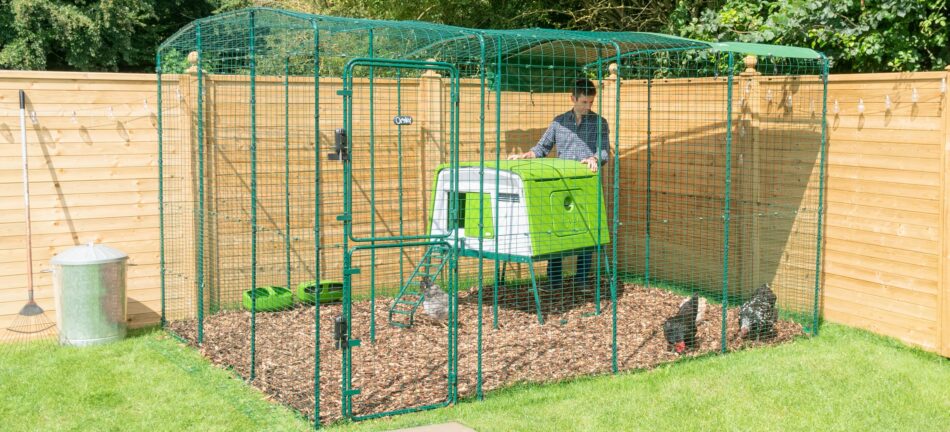

This entry was posted in Chickens
Chicks grow up quickly and soon it will be time to transition your chicks into their Eglu chicken coop. Their brooder will start to feel crowded after a few weeks, and your fully feathered pullets will be ready to strut out in a coop of their own. We’re here to help you make moving day an easy and stress-free experience.
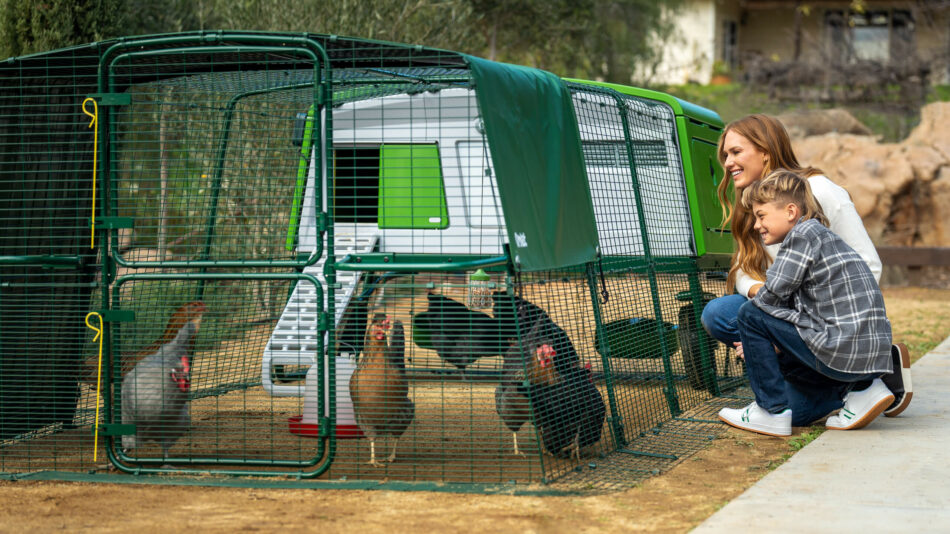
What age can chicks move into their Eglu chicken coop?
Chicks are usually fully feathered by the time they’re 6 weeks old, but not all chicks are ready to venture beyond their brooder at this age. Even though they’ve traded their fluffy down for mature feathers, they’re still very young. At Omlet, we recommend transitioning your chicks from their brooder to their Eglu chicken coop at 12 weeks of age.
Waiting until your chicks are 12 weeks old will give them time to become more coordinated and build the strength they need to navigate the bigger world outside of the brooder, and give them plenty of time to become familiar with their rise-to-roost schedule.
From brooder to coop
These 12 weeks will go by in a blink of an eye, so be sure to prepare for (and enjoy) your chicks’ time in the brooder. Caring for newly hatched chicks is exciting, and will set the tone for the rest of your relationship with them. Handling your chicks daily will help build a bond — and there’s no better time than when they’re in their brooder to kickstart this relationship. Once your little flock trusts you, it will make their transition to their coop even easier.
In the meantime, you can set up your flock’s walk in chicken run to take your chicks outside once they’re fully feathered. Keep these excursions short to make sure they don’t get chilled or draw the attention of other animals (including your other pets). If you plan to use an automatic chicken coop door, you can open and close it while your chicks are on their outing to get them used to the noise. Show your small flock where their chicken feeders and waterers are so that they’ll know where to find them once they move in.
Once your chicks are 12 weeks old and are all healthy and happy, it’s time to make the move to the coop. The big moving day should be based on the weather rather than a specific date. You want to look for a sunny day with moderate temperatures – ideally between 65-80℉. Avoid moving your chicks on windy or wet days, and try to move them as early as possible so that they can experience a full day and be ready to head to bed when night falls.
Tips for your chicks’ first night
If your brooder utilizes a brooding plate rather than a heat lamp, your chicks may already have the hang of going to bed at nightfall. But, being in a brooder is much different than being out in the big world, so even chicks that have an established sleep cycle may be caught off guard during their first night out.
First and foremost, you’ll want to keep your chicks safe from predators. The attached runs of the Eglu Pro chicken coops are predator-resistant, but your pullets will be much safer and more comfortable overnight in the roosting area inside of the coop. You may need to manually tuck your young hens in on their first night (or two) and close the door until they learn when bedtime is.
If you have an Autodoor, the coop light acts like a nightlight to guide sleepy heads to the roost. This is particularly helpful for chicks that were raised with a coop light – they’ll associate light with warmth and will seek it out when darkness falls.
New chicks and the existing pecking order
If you’re introducing your chicks to an existing flock, your older hens will help them learn the tips and tricks of the coop. But, older hens will also let newcomers know who’s in charge. Every flock of chickens has a hierarchy, and by understanding the pecking order in chickens you’ll be able to recognize what is normal hen behavior, or what constitutes bullying and the need to remove your chicks for their safety.
Most chicks fall into line quickly, just as most hens at the top of the pecking order aren’t ruthless tyrants. There are exceptions to the rule though, so be on the lookout for concerning behavior like:
- Hens keeping chicks away from food or out of the coop
- Scuffles severe enough to draw blood or cause excessive feather loss
- Pinning chicks down
If you notice your hens not accepting your chicks into the flock, try setting up an adjacent run or add walk in chicken run partitions to your setup to allow them to get to know each other through a safety barrier. It’s rare for hens to forever hold a grudge against new additions — so be patient, but also conscientious of the safety of your chicks.
Omlet and your chicks
Our products are designed to keep your flock safe – no matter their age, and to make caring for your chickens less of a chore and more of an enjoyable activity. The Eglu Pro chicken coop is perfect for growing flocks, especially when paired with our walk in chicken run. And, by installing an Smart Autodoor, you’ll have peace of mind from the start. Make moving day an enjoyable and memorable experience for you and your chicks, and set the tone for a lifetime of adventures together.
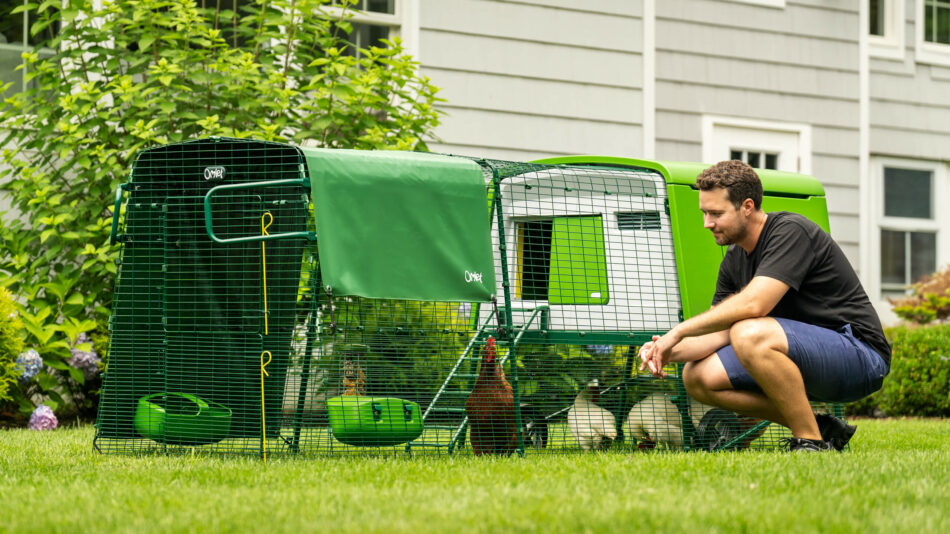

This entry was posted in Chickens
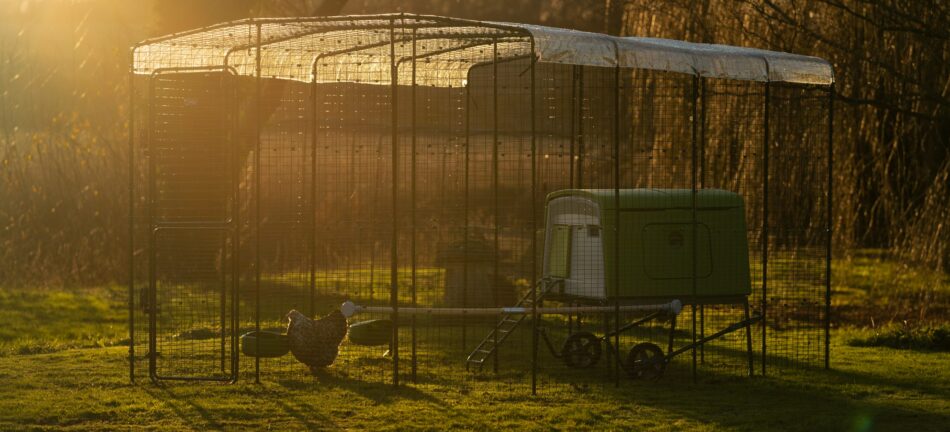
There are many references to spring and chickens, but hens are not exclusive to just one season. In fact, there are some breeds of chickens that prefer fall and its cooler temperatures. But, no matter if you have spring chickens or a fall flock, we’ve got the products to keep your hens happy all year long.
Should you get chickens in fall?
Fall and spring have a lot in common: moderate temperatures, change in the amounts of daylight and vegetation, and a great opportunity to try something new. Because of these ideal conditions, fall is an excellent time to consider getting chickens. Here are some reasons why fall may actually be better than spring for adding chickens to your backyard or existing flock:
- Cooler temperatures mean less stress for hens
- Shorter days encourage hens to learn their roost and wake routines quickly
- Less vegetation means more treats and opportunities for you to bond with your new hens
There’s also shorter, less dense grass in the fall — giving you the perfect opportunity to practice maneuvering your chicken tractor or to position your chicken coop. You may also want to consider raising chicks in the fall over the spring for the same reasons.
Why do some chicken breeds do better in fall?
What makes one breed of hen better than the next when it comes to seasonal changes and cooler temperatures? Hens have advantages that are displayed in the way they are built that will clue you in as to how likely they are to be a fan of fall. Their feathering, size, and even their combs and wattles are good indicators of if your hen is hardy in autumn.
Since chickens release heat through their combs and wattles, breeds with larger head adornments tend to do best in the heat. Conversely, hens with smaller combs and wattles are less likely to experience frostbite in the winter. Lean chickens fare better in the heat, and heavy hens weather the winter with ease. And so, in order to have a well-rounded chicken that will best tolerate the changing of the seasons, a balance must be found.
We’ve outlined some breeds of chickens that thrive in fall because of their general hardiness in all temperatures. Not all chicken keepers will experience cold temperatures during autumn, just like not all flocks are frozen in fall. The best hens to keep in the fall are those that are both cold and heat-tolerant.
Plymouth Rocks
Plymouth Rock chickens are known for their hardiness in most temperatures. They have moderate-sized combs and while they’re considered a heavy breed, they aren’t oversized. Plymouth Rocks are excellent layers of large brown eggs, and have a long lifespan of up to 10-12 years. Plymouth Rocks are typically “barred”, meaning their feathers are striped in pattern. Their black and white coloring will make them easy to spot among the fall foliage.
Possibly the most popular breed of chicken, Rhode Island Reds are hardy in just about every climate. They’re a dual-purpose breed (bred for both meat and eggs) but aren’t as heavy as hens bred exclusively for meat. They have moderate-sized combs and wattles, and are excellent layers of brown eggs. Rhode Island Reds are active, making them great choices for fall insect control.
Brahmas
They may be large, but Brahmas are surprisingly adaptable to both hot and cold climates. Their dense feathers keep them warm in cooler temperatures, and as long as they have access to cool water and shade, they will fare just fine as the weather warms up. Their legs are well protected by their feathers, but it’s important not to let them stand in mud — it can cake in their fluffy feet and lead to soreness. Due to their size, Brahmas won’t hop your garden fence to sample your autumn harvest.
Australorps
Australorps are essentially smaller versions of Orpingtons, but with just as impressive laying ability, with the world record of 364 eggs in 365 days being set by an Australorp hen. In addition to their prolific egg-laying, they are both heat and cold-hardy, adjusting to each season with ease. Their unique “beetle black” coloring sports a green hue when their feathers are fresh from their fall molting cycle.
Easter Eggers
Not an officially recognized breed, Easter Eggers are the result of crossing an Araucana and any other breed of chicken that lays brown eggs. The result is a rainbow of possibilities for eggshell color: from blue, green, and even pink-colored eggs. Because they can vary widely in appearance and build, Easter Eggers that are best suited to all seasons are of medium build with small or medium-sized wattles and combs. That being said, hybrid breeds are known for their health and hardiness — making them an excellent choice to start with in the fall.
Orpingtons
Orpingtons are generally recognized as a cold-hardy breed, but in recent years have gained a reputation for being tolerant of most weather. They may be on the heavier side, but their large combs and wattles help disperse heat to keep them cool in the summer months. Their head adornments may need some Vaseline in the winter to keep them from becoming frostbitten, but since Orpingtons are known as the “lapdogs” of chicken breeds, it should be an easy task. Their rich colors are a perfect complement to a fall palette.
Flock-raising in the fall
Regardless of breed, all chickens need a sturdy, comfortable home to thrive in the fall. The cooler temperatures, changes in vegetation, and shorter days all affect how your hens feel and behave. During this particular change in the seasons, you may be wondering how chicken keepers can prepare for fall. Some things to keep in mind are:
Preparing your chickens for fall can be an enjoyable task when you have the right setup. An easy-to-clean chicken coop goes a long way in helping to prepare for autumn, allowing you to get it fresh and clean for the new season with minimal time and effort.
Chickens scratching through your freshly raked leaf piles? Chicken fencing is a fast and easy solution to keeping your flocks from reaching certain areas. Omlet’s chicken fencing comes in multiple lengths, and can be arranged in any shape you desire. And, when the seasons change once again, the poles are easy to pick up and move to create a new area for your hens.
Omlet and your fall flock
Omlet supplies chicken keepers all over the world with products that not only last through the seasons, but provide ultimate support and comfort to chickens and their raisers. Our Eglu Cube chicken coop, chicken toys, and chicken fencing will meet all of your hens’ needs this fall – and make this season, and every season, the best experience with your flock.
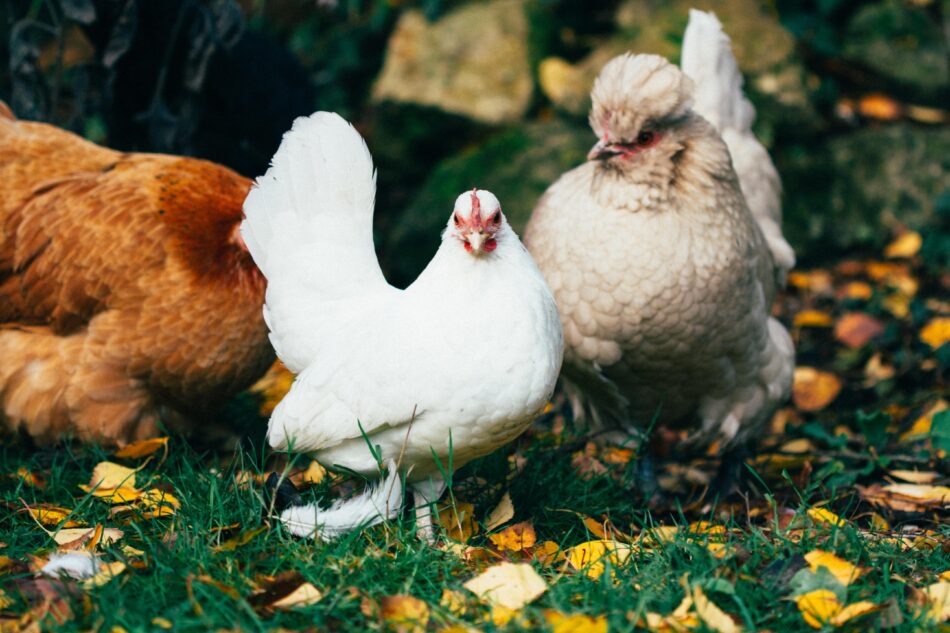

This entry was posted in Chickens
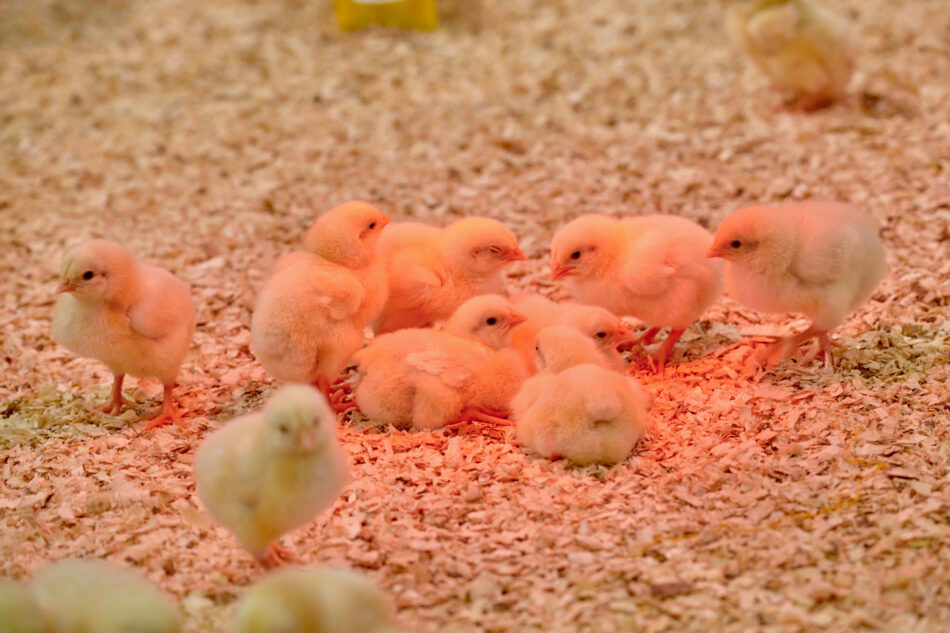
What is a chicken hatchery? How do they operate? Can anyone purchase chicks from a hatchery? How do you receive the chicks you’ve purchased? We’ve answered all of these questions and more in this informative guide to chicken hatcheries. And, if you’re considering purchasing chicks from a hatchery, we’ll help you determine how to choose a reputable one.
Chicken hatcheries are commercial operations that breed chickens, incubate their eggs, and sell the chicks they hatch. Some hatcheries breed and sell chicks all year round, while others may stick to the seasonal demand for chicks – usually in the spring.
There are no federal laws that govern chicken hatcheries (unless hatching eggs or chicks are being imported or exported), but individual states may have their own rules and regulations for hatcheries. Many states require chicks to be NPIP certified, or tested for certain diseases before being shipped or received.
The National Poultry Improvement Plan (NPIP) was a program that was developed in 1935 as a state to federal cooperative testing endeavor to maintain healthy chicken-raising standards. NPIP-certified hatcheries such as Meyer Hatchery are those that routinely send flock samples to be tested for a wide range of avian illnesses. NPIP certification also requires a tour of the hatchery’s facility to ensure safe and sanitary practices are being followed. To maintain their NPIP certification, a hatchery must keep clean facilities and flocks free of the diseases they routinely test for.
Why choose a chicken hatchery?
If you’re looking for a specific breed, or want a wide selection of chicken breeds, a chicken hatchery may be your best option. Chicken hatcheries often offer an array of different breeds and colors patterns, and may even part with older hens that are ready for retirement. Chicks can be shopped for, purchased, and shipped all through the hatchery’s website, and will be delivered to your local post office.
Hatcheries are usually NPIP certified and should be breeding chicks that conform to breed standards. This makes for not only healthy chicks, but also those that are good examples of the breeds they represent. Chicken hatcheries are also a great resource for you as a flock raiser when you have questions about caring for a particular breed, and can help you choose breeds that are best suited for your climate and lifestyle.
Some chicken hatcheries may vaccinate their chicks (usually for Marek’s disease) before they leave for their new homes. Vaccines are not required for chicks in the US, but may be an option for a nominal fee, or be standard practice for a particular hatchery. If vaccinating is not in line with your flock-raising philosophy, be sure to ask the hatchery if they can refrain from vaccinating your chicks.
Top 5 questions answered about chicken hatcheries
For anyone who hasn’t ordered chicks from a chicken hatchery, the process can seem daunting. We’ve compiled a list of the most common questions and concerns that revolve around ordering chicks from a hatchery so that you can feel confident in your decision.
How do I choose a reputable chicken hatchery?
While just about anyone can hatch chicks from eggs, hatcheries should have a verifiable history of selling healthy chicks. To ensure further quality control, choose a hatchery that is NPIP certified. Just like you would with other businesses, look at a chicken hatchery’s online reviews or talk to customers that have purchased from them before. Pictures of past hatched chicks, their breeding stock, and their facility are all telling of the quality of the chicks they have to offer.
You can also call a chicken hatchery in order to feel confident about purchasing chicks from them. Ask questions like:
- How long have you been selling chicks?
- Do you keep your breeding stock on site?
- Are you NPIP certified?
- Do you vaccinate your chicks?
Keep a record of the answers to these questions for each hatchery that you contact. This will help you make the most informed decision when it comes time to order your chicks.
What kinds of chickens do hatcheries offer?
Most hatcheries offer many different breeds of chickens, while some may specialize in meat or laying breeds. Chicks may be purchased as young as 24 hours old, while some hatcheries may offer older chicks or hens. A chicken hatchery’s website should have a catalog of the breeds they raise, along with their pricing and shipping requirements.
Can anyone buy chicks from a hatchery anytime?
The majority of hatcheries offer their chicks to the general public. Anyone can purchase chicks from these hatcheries, but they may have minimum purchase quantities or seasonal requirements. Some hatcheries may also be unable to ship to certain states, depending on their regulations, weather patterns along the way, or time constraints.
Spring is traditionally the peak season for hatcheries, but raising chicks in the fall is rising in popularity. Certain breeds fare better in colder temperatures, and are more likely to be fully-feathered by the time winter makes its appearance. Talk with your hatchery to see which breeds they recommend to raise in the fall.
Where can I find a chicken hatchery?
A quick Google search may yield several options for chicken hatcheries near you, or options for hatcheries that ship chicks all over the country. Many hatcheries have websites for you to view and purchase from, and should have all of their certifications on display. If you find a hatchery close to you, make sure they meet your criteria.
Purchasing chicks from a chicken hatchery
You’ve chosen your chicken hatchery, picked out your chicks, and are now ready to complete your purchase. But now what happens? There are a couple of different options when it comes to receiving your chicks.
How will I receive my chicks?
There are 2 potential ways of obtaining your chicks that you’ve purchased from a chicken hatchery. They are:
Many hatcheries offer local pickup if you live close by – though be sure to ask if this is an option before placing your order. Picking your chicks up from the hatchery will save on shipping costs and the potential stress that chicks may encounter during shipping.
However, some hatcheries do not allow customers onsite in order to protect their flocks from potential contamination. This is one reason why shipping chicks is commonplace with many hatcheries. A chicken hatchery may also be willing to meet you in a neutral place for you to pick up your chicks. This eliminates the risk of contaminating their facility, but may not always be possible with their schedule.
If picking your chicks up is an option, make sure you have the following items ready in your vehicle:
- A small, closed container with ventilation
- Bedding or towel for the container
- Handwarmers under a towel if the temperatures are cold and the drive is more than an hour
Shipped chicks
Some hatcheries offer shipping, but the United States Postal Service (USPS) is the only carrier that will ship live chicks – and they have strict rules that must be adhered to. The current regulations for shipping live chicks require them to be no more than 24 hours old at the time of shipment, and no more than 72 hours old by the time they arrive. The USPS will ship and receive chicks beyond this window, but they must be at least 6 weeks old and weigh at least 6 oz. The reason for this is that chicks have nutrients that are absorbed from the yolk upon hatching, which wanes by the time they are 72 hours old. As for older chicks, at 6 weeks old, chicks are usually fully-feathered and can withstand the variable temperatures of shipping.
Hatcheries that ship chicks may have order minimums depending on the time of year. During the colder months, chicks need to be shipped in larger quantities so that they can huddle together for extra warmth. Hatcheries may also put heat packs in the shipping containers with them.
Conversely, hatcheries may not ship during certain months if the weather is too hot. A good chicken hatchery will be weather aware of the routes their chicks must follow and will ship accordingly. This can be tricky with the 24-hour age rule, so be sure to talk to the hatchery before placing your order.
All chicks shipped in the US will be delivered via USPS to your local post office. Once your chicks arrive, your post office will call you to come pick them up. Be sure that your schedule is clear on the day that your chicks will arrive – chicks cannot be left unattended at the post office. Open your box right away to ensure your chicks have arrived safely, and that they match the description of the breeds you selected.
Getting ready for your chicks to arrive
Getting your brooder pen set up is an excellent way to busy yourself while you wait for your chicks to arrive. Familiarize yourself with basic chick care, and make sure you have all of your supplies ready for their arrival. Here’s a quick checklist of the items needed for newly hatched chicks:
- A brooder pen
- Heat source (brooder plate or heat lamp)
- A thermometer to place on the side of the brooder
- Chick feed
- Chick grit
- Feeders and waterers designed for chicks
This is also a great time to be thinking about their permanent setup once they’re ready to leave their brooder. Once chicks are 12 weeks old, they’ll be ready to move into the Eglu Cube chicken coop for their permanent home. While your chicks are happily growing in the brooder, you can spend your time choosing the spot for their coop, assembling it, and familiarizing yourself with it before your chicks make the big move from brooder to coop.
Omlet and your hatchery chicks
It’s exciting to welcome new chicks home to a brooder, but what about when it’s time for them to move outdoors? Omlet’s Eglu Cube chicken coop is your all-in-one solution for chicks 12 weeks and older. Have confidence in ordering, caring for, and transitioning your chicken hatchery chicks when you rely on Omlet.
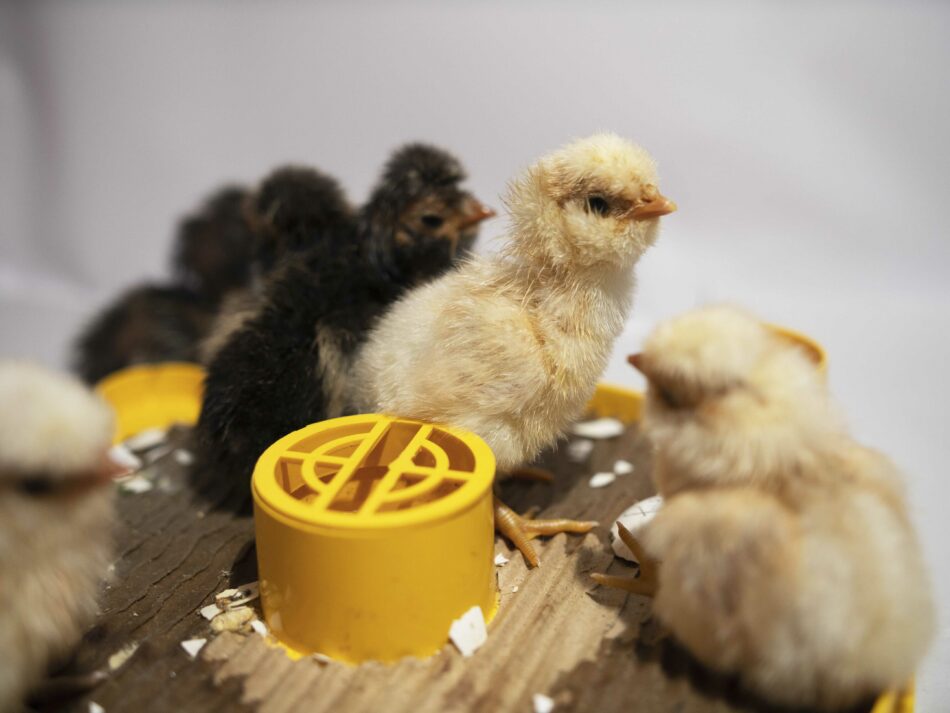

This entry was posted in Chickens
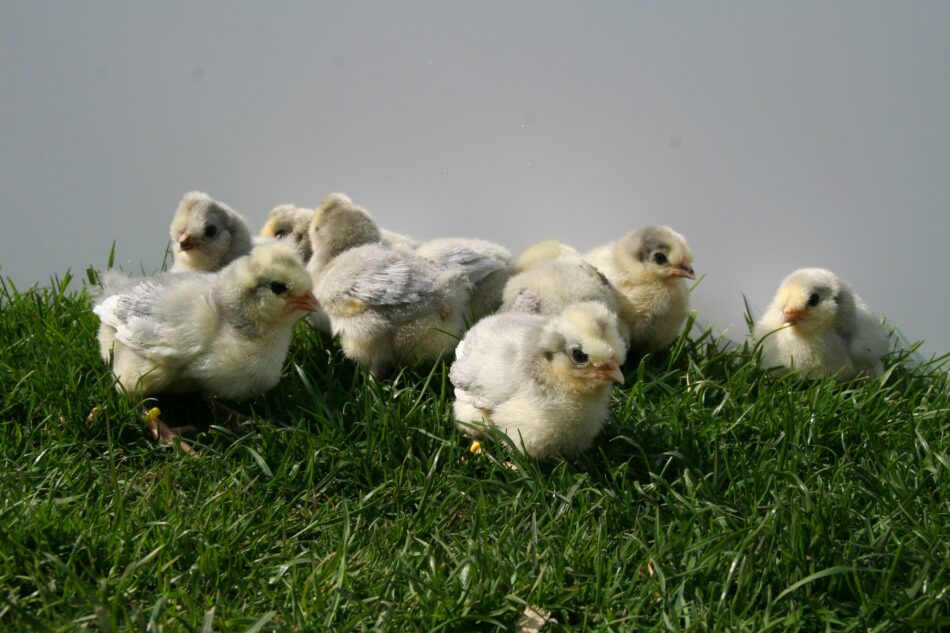
Worried about keeping chicks safe from predators? It’s a valid concern – chicks are more vulnerable to attacks from predators than full-grown hens, and they’re more naive to the wily ways of these skillful hunters. Thankfully, we’ve designed solutions to keep chicks safe from harm. Discover which predators pose the highest risk to young chicks, and see how Omlet can help keep even your smallest flock members safe.
Why are chicks a target for predators?
Chicks are an easy target for predators because of their size and lack of experience with other animals. While chickens are all born with an innate sense of danger, chicks learn a lot through experience or from example with a mother hen. Chicks raised in a brooder being handled by humans daily don’t have this learning opportunity.
You’ll notice most (if not all) chicks will be skittish of things that move quickly or make a sudden noise, like your hand or if you clear your throat. They’ll startle or scatter at the sight of a pet dog or cat, or may even be alarmed at your sudden presence over the brooder pen. These are all normal behaviors for a chick, which, unfortunately, are well-recognized by skilled predators. They’ll bide their time and are well practiced in moving in a stealthy manner to surprise their unsuspecting prey.
When can chicks move outside?
You can start moving your chicks outside once they are fully feathered, which usually occurs between 6-8 weeks of age for most breeds. Once they’ve reached this milestone, you can begin taking them outside for supervised stints to explore their coop and run. Choose warm, sunny days so that they don’t get chilled, and make sure you can stay with them for the entirety of their excursion.
It’s important to keep your chicks close by and in a fully enclosed area during their visits to the great outdoors. Predators will gladly take advantage of exposed or unprotected chicks. Chicks will draw attention from predators easily, as they will be excitedly pecking, hopping, and scratching around in their new environment. Because of this, it’s vital to make sure they are fully protected while outside.
Once chicks are 12 weeks old, they can move into their Omlet chicken coop full-time. This recommendation is based not only on a chick’s development, but also to ensure they are large enough to navigate the ladder of raised coops, or to be comfortable with heading in to roost on time.

5 chick predators
While any chicken predator can pose a risk to your chicks, there are some that are more apt to go after your small flock members because of their size. Similarly, the predators that would make a quick meal of a chick can also pose a threat to full-grown hens. But to help you better prepare your setup for your new flock members, we’ve compiled a list of predators that are likely to pose the most risk to your chicks in particular.
Rats
Rats may be small, but a young chick is no match for them. While they are normally scavengers, rats are also opportunistic eaters and won’t hesitate to go after a live chick if they’re hungry. One swift bite from a rat can spell the end for a chick.
The best way to keep rats away from your chicken coop is to make sure there is no food left out in the run overnight. Collect any uneaten chick food each evening and keep all feed in airtight containers. You can also offer treats in a Caddi Chicken Treat Holder and offer scratch grains in a chicken peck toy to prevent waste and keep the floor of the run clean.
Raccoons
Raccoons are notorious for reaching through the openings in runs to grab poultry. Their attacks are calculated and macabre – raccoons may only take the heads of their prey, leaving the rest of the carcass in the run. But, if chicks are small enough to fit through the openings, a raccoon will take their prey and leave no trace of their visit.
To keep chickens safe from raccoons, the attached run of the Eglu Cube has a tighter mesh pattern along the bottom of the run, that slowly graduates to larger openings as the mesh ascends. The doors are also fitted with t-locking handles that require opposable thumbs to open. This prevents raccoons from using their paws to grab chicks through the run, or turn the handles of the coop doors.
Snakes
Similar to raccoons, snakes will take advantage of small gaps or openings in chicken pens. One of the most common and troublesome reptiles that go after chicks are rat snakes – also aptly called “chicken snakes.” These non-venomous snakes can grow to be 42-72 inches in length, and use the method of constriction to immobilize their prey. While they prefer rodents or chicken eggs, they will happily constrict and swallow chicks.
As a general rule, snakes can get through any opening that their head fits in. To protect your chicks from snakes, you must have openings less than ½ inch along the bottom 4 feet of the run. And, if your run is around any shrubs or trees you’ll need this protection along the top as well – rat snakes are avid climbers and can get the drop on your coop. Chicken run covers can be used along with hardware cloth to help keep snakes out of the run.
Birds of prey
Birds of prey like hawks, eagles, or owls, primarily pose a risk of aerial attacks. These birds will swoop down and grab any small animal they think they can pick up. Some large birds have even been known to attack through the sides of a run much like a raccoon – grabbing any nearby chicks and pulling them through the opening.
The attached run of the Eglu Cube has a fully enclosed top to prevent attacks from above, and the tight mesh along the bottom protects your chicks from side-swiping efforts. Keep your chicks’ feed in airtight containers, and their feeders and waterers out of sight from birds of prey to not draw unwanted attention.
Domestic dogs and cats
Sometimes the biggest threat to your chicks can be a member of your own family. Dogs and cats can accidentally hurt chicks, or intentionally go after them if they have a high prey drive. Even calm dogs and cats can become easily excitable when they hear or see chicks in their backyard.
Keep your dog on a leash when introducing them to your chicks for the first time, and always through the safety of a sturdy barrier like the attached run of the Eglu Cube. Cats should also be monitored closely when they’re introduced to your chicks.
Keeping chicks safe
You’ve spent weeks taking care of your chicks in a brooder, so it’s only natural to be apprehensive when you first move them outside. From their first moments in their outdoor setup, you’ll want them to be as safe as possible.
By connecting a walk in chicken run to your Eglu Cube, your chicks will have plenty of protected space to explore and play in their new surroundings. And, just like the attached chicken runs of our chicken coops, the walk in chicken run features anti-dig skirting to prevent predators from tunneling in.
To add even more security to your Eglu Cube, an Automatic Chicken Coop Door can be integrated seamlessly for not just an automated schedule, but an extra layer of security. The horizontal opening mechanism makes it extremely difficult for predators to pry open, and your chicks will be tucked in safely each night on time – with or without you being there.
Omlet and keeping your flock safe
Omlet’s products have been designed with security at the forefront. Whether you have an existing flock that you’re adding chicks to or are getting chicks to begin your chicken-keeping journey, our products will keep them safe. The walk in chicken run, Autodoor, and Eglu Cube have all been designed to keep flocks of all stages and ages protected for a lifetime. When you choose an Omlet setup to house your chicks, it will be the only one you ever need.
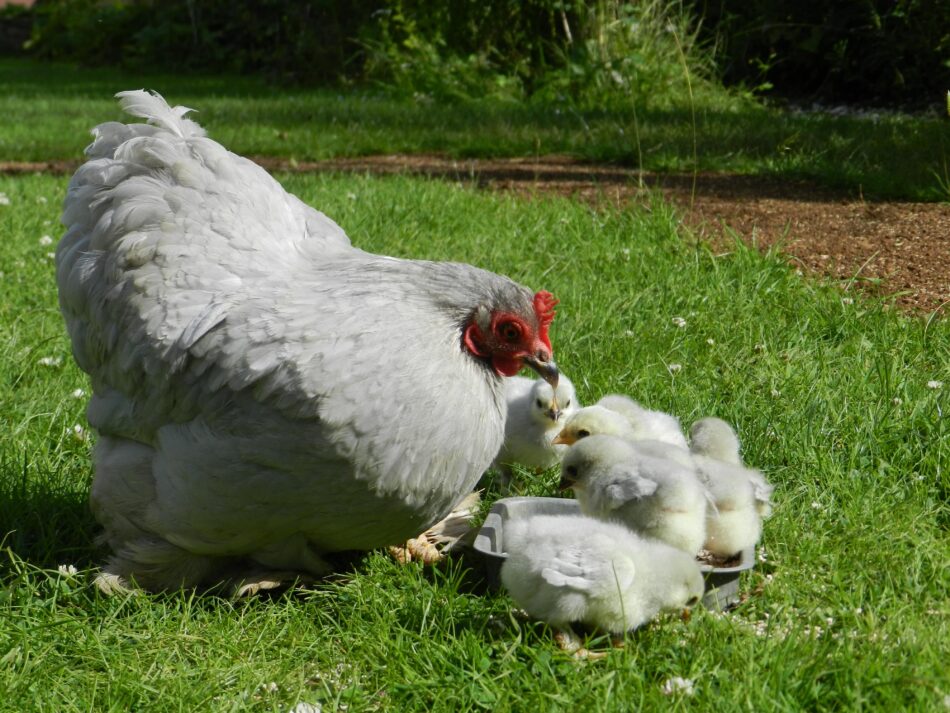
This entry was posted in Chickens

Chicken eggs are considered one of the healthiest food sources. Packed with essential nutrients and protein, it’s a staple in most family diets. But even more than a food source, chicken eggs are fun to gather, display, and hatch. Learn how to encourage your hens to lay beautiful eggs all year long, store these labors of love, and even hatch fertilized eggs with the help of an incubator or broody hen.
Creating the perfect environment for chicken egg laying
First and foremost, hens need a safe, quiet space to lay their eggs. Hens will naturally seek out the most suitable place to lay a chicken egg – so if a designated nesting area isn’t supplied to them, hens will venture off in search of the right spot. The ideal nesting area is in a covered space like a chicken coop, away from your flock’s active areas. Enclosed nesting boxes or spaces are preferred, as hens will instinctively want their eggs safe from chicken predators.
Omlet’s hen houses have designated nesting areas inside that are comfortable and secluded. Hens will feel safe inside of their enclosed coop’s nesting area, and with the rest of the flock out for the day, will have the privacy needed to encourage egg laying.
How to encourage egg laying
Good laying hens can produce over 250 eggs per year without much supplemental encouragement. As long as they have adequate space and nutrition, their natural egg-laying cycles should remain intact. Aim to give your flock as much space as possible outside of the coop, whether free-ranging with the help of chicken fencing or in a chicken run.
Laying hens should have a diet consisting of:
- Quality scratch grains and chicken treats offered daily
- Access to fresh, clean water in a chicken waterer
- Free-choice of high-quality layer pellets or crumbles, with protein levels between 16%-18% depending on their breed
- Fresh greens or grass as often as possible
What to do if your hens stop laying eggs
If you notice fewer eggs in the nesting area, it’s time to perform a health check on your chickens. Any hens with noticeable discomfort should be quarantined, and you should contact your veterinarian. If all of your hens appear healthy, there are 6 other ways to boost egg production among your flock:
- Offer chicken supplements
- Increase the protein of your hens’ diet
- Switch to a different feed
- Make sure your hens are visiting the nesting box, as they could be laying eggs elsewhere
- If you have a broody hen among your flock, it may affect your other hens’ cycles
- Make sure your hens are not molting, as egg production will decrease for several weeks during a molt
If these methods don’t help or give you insight into any potential issues, contact your veterinarian.
How and when to collect your hens’ eggs
It’s important to collect your chickens eggs daily. Eggs left in nesting areas are at risk of being cracked or broken by multiple hens using the nest. And, eggs left in the coop may draw in pests or predators like rats or snakes.
How often hens lay eggs
Good laying hens will produce an egg approximately every day and a half. The majority of hens will lay their eggs in the late morning or early afternoon hours, but there may be some stragglers toward the end of the day. It’s very uncommon for hens to lay their eggs overnight. This means that early evening would be the best time to check your coop for chicken eggs.
If you’re concerned about how long your hens’ eggs can stay in the coop, try to collect them at least once a day. But, in general, eggs are still safe to consume even if they are left to sit in the coop for several days. The hot summer months will reduce this timeframe, but eggs are still safe to consume after exposure to the heat. Winter months pose a challenge due to the risk of eggs freezing in the coop. If your area experiences prolonged temperatures below freezing, you may want to check your coop several times a day before eggs have a chance to freeze solid.
Daily egg collections
Daily egg collections will also help deter hens from going broody. If you want to keep hens from becoming broody, remove any eggs from under a hen that has been sitting for longer than usual to lay an egg. Be cautious – even the most docile hens can get aggressive when protecting a clutch of eggs they’ve decided to sit on.
How to tell if a chicken egg is fertilized
Eggs require a rooster in order to be fertilized. Roosters fertilize the eggs before they are laid, so if you have a rooster in your flock, there’s a potential for any of your hens’ eggs to be fertilized.
There are some misconceptions about roosters, eggs, and fertilization. The most common ones are:
- Hens do NOT need a rooster to produce eggs – they will lay eggs regardless
- Not all chicken eggs will be fertilized if you have a rooster in your flock
- The only way to know if a freshly laid egg is fertilized is to crack it open
If you’re interested in hatching your own chicken eggs, the best method is to pay attention to the eggs you’re eating. When you crack them open, look for a “bullseye” pattern in the yolk. This subtle change that appears as a target will be your clue that the egg is fertilized. If you notice most of the eggs you’re cracking are fertilized, start saving a few to place in an incubator. After 1 week in the incubator, you’ll be able to candle the eggs to see if there is embryonic development.
How to hatch eggs
Hatching your own eggs is an exciting experience. If you choose to incubate your eggs instead of having a broody hen sit on them, you’ll be able to document their progress by using an egg candler. This special light will help you see how the chicks are developing, and will help you dispose of any unfertilized eggs before they spoil and burst.
To hatch your own chicken eggs, you’ll need:
- An incubator
- Thermometer (if not included in your incubator)
- Hygrometer to monitor humidity level
- Egg candler (optional)
Chicken eggs take 21 days to hatch from the time of incubation. It’s best to place eggs in the incubator as soon as possible, but if you must store eggs before incubation, they can be kept in temperatures between 55-65℉ for up to 7 days.
On day 18 of incubation, you’ll want to “lockdown” your incubator. This means you’ll add water if needed (humidity levels need to increase to 65-70% in the final 3 days before hatching). Turn off any automatic turners, or stop hand-turning your eggs on day 18, and place a non-slip covering on the hatching floor of your incubator so that newly hatched chicks do not develop splayed legs. A paper towel or non-slip shelf liner that will allow ventilation are both good options.
Taking care of chicks once they’ve hatched
Once your chicks have hatched, be sure to leave them in the incubator until they are dry and fluffy. This will ensure they don’t get chilled when they’re moved to their brooder pen. The nutrients that fed chicks while they were inside of their eggs will sustain them for up to 48 hours after hatching, so it’s safe to allow them to fully dry before moving them.
When raising newly hatched chicks, make sure you have:
- A secure brooder pen with a top to prevent escapes
- A heat source like a brooder plate or lamp
- Chick starter crumbles – medicated or non-medicated depending on your preference
- Chick-specific feeders and waterers
- Absorbent bedding like pine shavings or pellets
- Adequate time to check in on your chicks daily
Chicks can be quite messy as they work on their coordination. Waterers should be checked frequently for debris to make sure they have access to clean water, and feed should be refreshed. Growing up is tough work, and chicks will need to consume a lot of feed.
The benefits of having your own egg-laying chickens
There are many benefits to keeping your own chickens, like:
There’s nothing like gathering freshly laid eggs from your own flock of chickens. Proudly display your hens’ labors of love in an egg skelter on your kitchen counter, or gift friends and family members with small packs of eggs.
Best breeds for egg laying
There are many different breeds of chickens, many of which are known for their proficiency in laying eggs. Some of the best breeds for egg laying include:
Chickens that are bred for ornamental purposes will still lay eggs, but at a much lower volume than laying breeds. Bantam (miniature varieties of full-sized breeds) also lay eggs, but they are much smaller and less frequent than their full-sized counterparts.
Cleaning your eggs with care
Storing fresh chicken eggs depends on how quickly they’ll be used, and as a matter of personal preference. There are two main ways to keep backyard eggs fresh:
- Leaving them unwashed and set out at room temperature
- Washing them and storing them in the refrigerator
It’s very important that any eggs left out at room temperature remain unwashed. Introducing eggs to water or cleaning solution removes the bloom (microscopic protective barrier) from the shell. Egg shells are semipermeable – meaning air and moisture can pass in and out. Once the bloom has been washed off, the eggshell loses its natural barrier to keep harmful bacteria out.
Unwashed eggs can also be stored in the refrigerator, but washed eggs must be stored in the refrigerator to remain fresh. That’s why store-bought eggs are refrigerated – they have all been washed.
If you choose to wash your eggs, you can either make a DIY egg cleaning solution from vinegar or purchase ready-made egg cleaning products. Or, if you want to simply use water, soak your eggs in warm water, as this will help keep bacteria from entering through the pores of the shell. After a nice soak, gently rub your eggs with a cloth or soft-bristled brush. Dry with a towel, and promptly place your cleaned eggs in the fridge.
Chicken egg color guide
Did you know your hens’ eggshell colors are the result of genetics? Hens will lay the same colored eggs their entire lives. Some breeds are bred to lay specific colors, while other breeds differ from hen to hen. Sometimes nutrition or health changes can subtly impact the color or appearance of your hens’ eggs, but you should expect consistency from your hens.
Common chicken eggshell colors include white or cream, and browns in various hues. Chicken eggs can also be blue, green, and even pink. Most eggs are a solid color, but some breeds like Marans, Barnevelders, and Welsummers can lay speckled eggs.
Your hens’ eggs tell about their health. Sometimes misshapen, discolored, or eggs laid with shell anomalies point to a nutritional deficit. If you notice your hens laying eggs that aren’t consistent with their previous appearances, it’s best to evaluate their diet.
Frequently asked questions about chicken eggs
How frequently do chickens lay eggs?
Every hen is different, but peak age for most laying hens is around a year and a half through 2 or 3 years of age. During that time, a good laying hen should produce anywhere from 250-350 eggs per year depending on their genetics. Egg production will decrease as hens age, and will also dip or stop altogether during their yearly molting cycle. Some hens may also decrease egg production in the wintertime to reallocate energy to stay warm.
Do chickens stop laying at a certain age?
Depending on their breed, most chickens will stop laying eggs by the time they are 4 or 5 years old. There are some breeds of chickens that will lay well into their later years, while others will drastically decrease production by year 3 or 4.
How do chickens lay eggs?
Chickens ovulate in order to lay an egg. Ovulation takes about 24 hours to complete, and starts in the ovary. The yolk is formed first, then passes through the oviduct where it is surrounded by the white (also called the albumen). Finally, the egg is encased in its shell inside of the hen’s uterus (or “shell gland”). Shell formation takes roughly 20 hours, after which the egg is laid by the hen via the cloaca or “vent”. All excretions from the hen exit through the vent, but during egg laying a hens’ uterine lining stays with the egg until it has been deposited – keeping it nice and clean.
Do chickens eat their own eggs?
Hens may begin to eat their own eggs for the following reasons:
- Nutritional deficiencies – usually low calcium intake
- Dehydration
- Boredom
- Stress
- Feeling unsafe in the nesting area
Keep your hens from eating their eggs by supplementing their diet with calcium. Crushed oyster shells can be purchased from feed stores, or you can save the eggshells from eggs you are using to crush and feed back to your hens for a boost in calcium. Always make sure your hens have plenty of fresh water to ward off dehydration.
Provide boredom-busting activities with chicken toys, and make sure your hens are housed in secure chicken coops and chicken runs. Hens that don’t feel safe may eat their eggs to hide evidence of their presence from chicken predators. Consider installing an automatic chicken coop door to make your hens’ feel more secure in their home.
Get more chicken eggs with Omlet
All of our chicken products are designed to promote safety, comfort, and security for hens, and for ease of use for their caretakers. Healthy, happy hens lay more eggs – so give them plenty to occupy their busy minds. A walk in chicken run gives your flock ample room outside of the coop to forage and play. Add a Chicken Swing to give your hens a unique place to relax in between egg-laying sessions, and to provide versatility in their space.
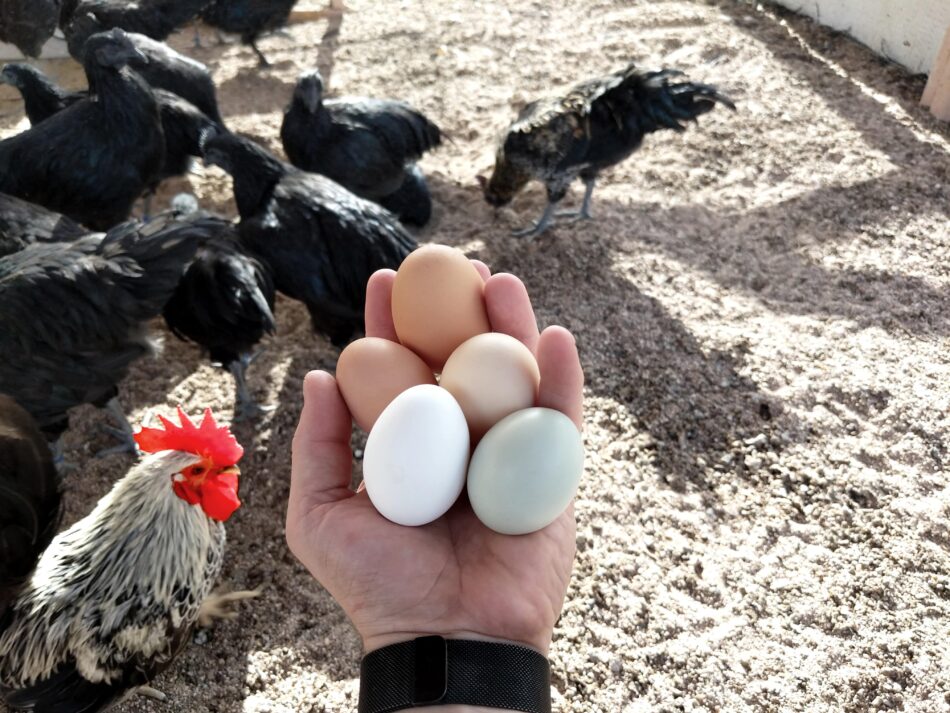
This entry was posted in Chickens
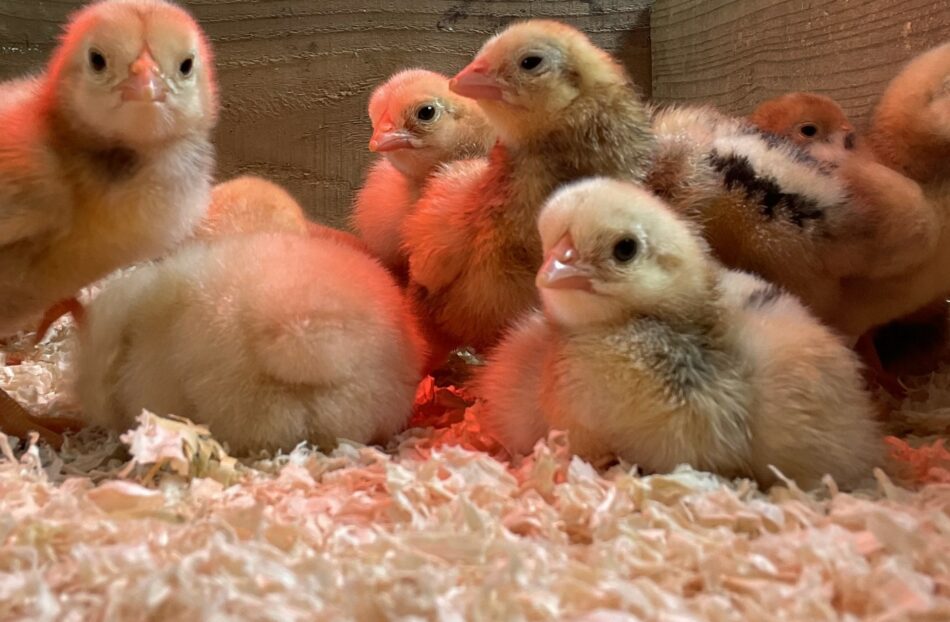
Chicks are generally associated with springtime, but have you thought about raising chicks in the fall? Getting an earlier start to raising your chicks means they’ll start laying their first eggs during the spring, and watching chicks grow during the winter months is a welcome change from an otherwise stagnant season for growth. Of course, there are a few modifications to be made when starting out with chicks in the fall instead of spring, but with the right setup, your fall chicks will successfully grow into spring chickens.
Benefits of raising chicks in fall
Like spring, fall is a season of change. In nature, birds (your hens included) are more likely to sit on a nest of eggs in the spring, knowing there will be lush vegetation and warmer weather for their chicks to thrive in. But, with a helping human hand, those conditions can be simulated in your own backyard.
Cooler temperatures for brooders
This consideration is especially important for flock-raisers in warmer climates. Since chicks need to be kept under a heat source until they are fully feathered, the added heat in already warm weather can turn dangerous in a hurry. Chicks may succumb to heat stroke if they get too warm in their brooder – particularly closed brooder pens. In the mild temperatures of fall, your chicks aren’t at risk of overheating from the weather in addition to their brooder plate or lamp.
Fully feathered before winter
Chicks are fully feathered by 6-12 weeks, depending on their breed. By the time they are 12 weeks old, they are ready to move into their Eglu Cube chicken coop. With the dual-layer insulation of the Eglu Cube, you’ll feel confident about moving your young adult hens to their outdoor setup, knowing they’ll be warm in the falling temperatures.
You’ll still want to coordinate when to move your chicks outside with the weather. Choose a week where the lows at night will be 50℉ or above to help their transition easier. Most chicks hatched in September will be ready to move into their Eglu Cube by November – which is well in advance of most areas experiencing frigid temperatures.
Fresh eggs by spring
When chicks are hatched in the spring, their long-awaited first egg usually does not make its appearance until late summer. And, since some climates see scorching summer temperatures, sometimes their first eggs are delayed until the fall. Egg production is difficult for a newly-mature hen to master while trying to keep their energy expenditure to a minimum.
Your fall chicks will be able to supply your family with fresh eggs by the time spring comes around. And, since they’ll have a season of egg laying under their belts, the likelihood of them continuing their egg production through the summer is much higher than if they had just gotten started. And, with a fun accessory like an egg skelter, your kitchen will be ready for spring and a steady supply of eggs.
Preparation for raising chicks in fall
Obtaining chicks in the fall may be slightly more difficult than in the spring. Large retailers that usually sell chicks in the spring will likely not carry chicks any other time of the year. But, hatcheries typically ship chicks all year round, depending on your location. Their breed selection may be more limited in the fall, so be sure to ask if you can request a particular breed, or if the breed you intend to raise will be available.
Other options include:
- Incubating fertilized eggs (purchased from a breeder, or from your own flock if you have a rooster)
- Buying chicks from individuals or breeders
Some breeders may have waiting lists in preparation for the slower seasons, to reach out sooner rather than later to secure your chicks.
Safely raising chicks in fall
Fall may be an “off-season” for chicks, but that doesn’t mean that chicks can’t be successfully and safely raised this time of the year. In fact, in some parts of the US, it may actually be more beneficial to raise chicks in the fall instead of the spring.
Predator activity
Predators are much more active in the spring than in the fall. Those that are still active in the fall will decrease their movement as the temperatures decline – which means by the time your chicks are old enough to move to their outdoor setup. While your chicks are in their brooder, you can make adjustments to their chicken coop and run to make it more predator resistant – without having extra vegetation making modifications more difficult.
Dietary considerations
Chicks don’t need rich foods like treats or insects until they have grown accustomed to their feed. If offered these foods too soon, they will prefer them over the balanced diet that laying pellets or crumbles provide. Fall and winter offer much fewer insects and grazing opportunities than springtime – ensuring your chicks will adhere and grow to love their diet that you’ve painstakingly planned out for them.
This same school of thought applies to any adult hens you may adopt during the fall. As part of your fall chicken coop preparations, you can make sure your new additions grow accustomed to the new diet they’re offered. By spring, they’ll be familiar with and well nourished by their laying feed.
Omlet and your fall chicks
No matter what time of the year, Omlet makes it safe and enjoyable to raise chickens. With our safe and comfortable Eglu chicken coop and run and Chicken coop weather protection, your fall chicks will be ready for the wintertime in their outdoor setup. Be sure to grab an egg skelter along with your chicks for the fall – you’ll be needing it to display those fresh eggs by the beginning of spring.


This entry was posted in Chickens

Keeping chickens is a great pastime for people of all ages and walks of life. Backyard chicken keeping is rising in popularity, with more states and cities allowing small flocks in residential areas. With a few tips and tricks and a great setup, you can enjoy keeping your own flock of chickens in your own backyard.
Are chickens the right pets for me?
Some of the things you’ll need to consider before keeping chickens are:
Chickens make wonderful pets that provide entertainment, companionship, and of course, eggs. The time needed to keep hens healthy and happy is flexible – and largely dependent on the breeds you’ve chosen and how you choose to keep your chickens. You can plan to spend anywhere from 1 to 4 hours per day tending to your flock.
Your flock will thrive on as much space you can feasibly provide them with. Hens naturally want to explore, forage, and scratch around in the earth, so the bigger the area, the more room for these activities.
Which chicken breed should I choose?
These breeds need more space than other breeds due to their desire to run and forage, or their size. Breeds that do well in confinement or smaller spaces include:
Chicken keeping laws
Laws concerning keeping chickens may apply to you if you live in a neighborhood – particularly if you’re part of a homeowners association (HOA). Each state has their own laws regarding keeping chickens, and each city may have different laws within a state. And, just because your state and city allow chickens doesn’t mean your HOA does – be sure to contact your city zoning office and HOA board before getting chickens to see what the rules are. Rules about flocks of chickens will likely include:
Where to buy hens & chicks
You can obtain your flock from breeders and hatcheries year-round, or from feed supply stores during the spring and summer months. Breeders may have adult hens for purchase, or you may be able to adopt grown chickens from individuals and rescue groups.
Chicks are fluffy and cute, and it may be tempting to start out with chicks instead of adult hens, but they require extra care and supplies that grown chickens do not. To raise chicks you’ll need:
- A special enclosure called a brooder pen
- Heat lamps or brooding plates
- Chick-specific feeders and waterers
- Feed formulated for chicks
Chicks need a heat source until they’re between 6 and 12 weeks old, depending on their breed. During this time they must be kept in their brooder pen and out of the elements, with short visits outside to slowly acclimate them to their environment.
Raising chicks can be rewarding, but if you don’t want to wait several months for your first eggs, or have to go through the process of keeping chicks in a brooder, starting with adult hens may be the best choice for you. Adult hens can go straight to your setup. And, with most breeds beginning to lay eggs by 16-20 weeks of age, older hens will be able to provide eggs for your family right away.
Choosing a coop
The best beginner chicken coop is one that will last a lifetime, with the ability to grow and be customized to accommodate your flock. Large chicken coops are best to start with, so that you have plenty of room to add to your flock, and to give your existing hens as much space as possible.
Omlet’s chicken coops have everything you need to get started keeping chickens. When choosing your chicken coop, you’ll want to weigh what is most important. Safety, comfort, and functionality should never be compromised in your chickens’ coop. When choosing between a wooden and plastic chicken coop, consider all of the upkeep involved with a wooden coop, and how difficult they are to clean. Our plastic chicken coops are easy to clean and keep your flock comfortable and protected all year round.
Choosing a chicken run
A chicken run will benefit your flock in many ways. From keeping them out of your prized flowers, to keeping them protected from predators, chicken runs help keep your hens healthy and happy. And, with the right chicken run, it will make keeping chickens even easier.
Walk in chicken runs are perfect for both keepers and flocks. They’re tall enough to give you access to walk with your flock, and offer enough space for them to exercise and explore their surroundings. All of our walk in runs feature anti-dig skirting to help prevent predators from tunneling in, and are fully enclosed with roof panels. And, with walk in chicken run extensions and chicken weather protection it’s easy to customize their experience and keep them sheltered from the elements.
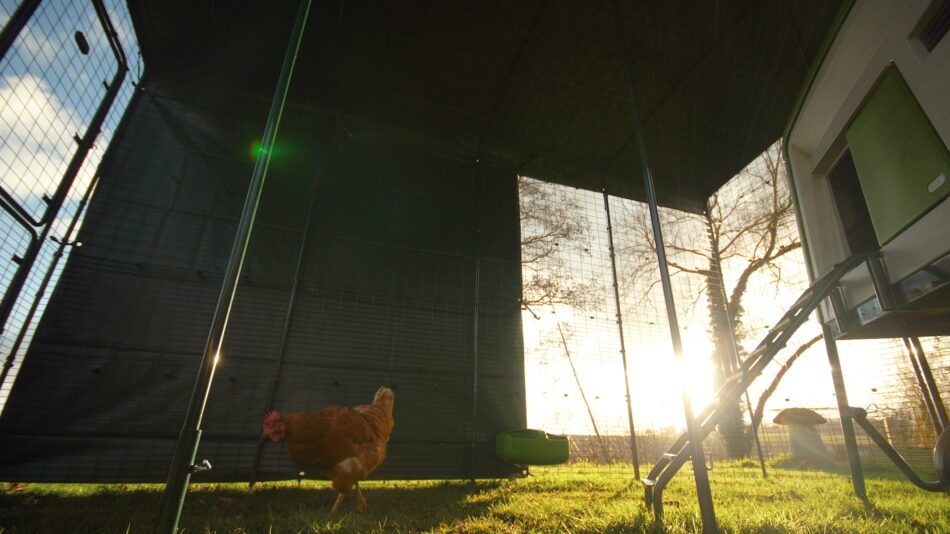
Keeping your chickens protected from predators
Chickens are animals of prey, so it’s up to their keepers to keep them safe from predators. Along with a strong chicken coop and predator-resistant chicken run, an automatic chicken coop door is an extra layer of protection against invaders. Chicken predators are most active at night, so by having a coop door that closes automatically either based on the sun or a certain time, you’ll make sure they’re tucked in tight when they’re at their most vulnerable.
Keeping your chickens fed & watered
Chicken feeders and drinkers are an essential part of keeping chickens. They should be elevated enough to deter hungry rodents, and have a covering to keep moisture out and to prevent your hens from tossing food around. Chickens should be offered quality layer pellets free-choice, along with occasional chicken treats.
Your flock should also have clean, fresh water available at all times. In the summer, toss ice cubes into their waterers to keep them cool. In the winter, break ice often to make sure your hens have access to thawed water.
Entertaining your flock
Like most pets, chickens enjoy toys. It’s a way for them to entertain themselves and engage both their bodies and brains. Our unique flock favorites include:
When you add these enrichment items to your hens’ space, you’re adding joy for everyone. There’s nothing quite like watching your chickens exhibit their natural behaviors through play.
Encouraging egg production
When provided with quality food and safe housing, hens will start laying sometime between 16-20 weeks of age. There are ways to encourage your hens to lay eggs during periods of stress, but healthy hens will lay all year round with the exception of molting season (usually mid-late fall). Your chickens’ eggs can remain in the coop for several days without compromising their nutritional value, but gathering them daily is the best practice.
Store fresh, unwashed eggs at room temperature for weeks, or even longer in the refrigerator. Egg skelters are unique and functional display pieces to showcase the fruits of your laying hens’ labor.
A typical chicken-keeping routine
Your daily routine with your flock will probably look something like this:
Morning
- Let chickens out of their coop
- Dump the droppings tray, wipe it down, and refresh bedding
- Top off feeders and waterers for the day
Afternoon
- Check for eggs
- Ensure water is fresh and at a palatable temperature
Evening
- Ensure your hens are in their coop for the night
- Remove any leftover food from the run to discourage rodents from visiting
You’ll quickly learn the best time to offer treats and socialize with your hens based on their personalities. Some hens are more active in the morning, while others may be more willing to socialize in the evenings. Hens will usually lay their eggs late morning through late afternoon, and it’s best to give them their privacy during this time. Plan coop cleanings around your flock’s laying schedule.
Common chicken health problems
Chickens are generally hardy pets that are resilient in many climates and conditions. Healthy chickens are bright and alert with good appetites and a predictable laying schedule. And, your hens’ eggs can be a good indicator of their overall health.
There are no mandatory chicken vaccines in the US, and very few are approved for use in backyard flocks. The best way to keep your hens healthy is to perform regular chicken health checks. If you find anything unusual or suspect your chicken is ill, report your findings to your veterinarian.
Rarely, backyard flocks can contract avian flu, which is spread through the droppings and saliva of wild birds. Since there is no treatment for avian flu in chickens, covering your chickens’ run is the best way to prevent them from contracting the illness.
What to avoid when chicken keeping
Keeping chickens should be relaxing and enjoyable for both the flock and their owners. To eliminate potential stress while tending to your hens, avoid:
- Starting out with roosters
- Buying a wooden chicken coop that will rot and need constant repairs
- Setups without enough space for your flock
- Coops and runs that cannot be added onto or customized later
Chicken keeping with Omlet
Omlet is here to support you through your chicken-keeping journey – right from the beginning. From our fun and quirky chicken clothing to our practical and beloved chicken perches, we’ve got everything you need to get the most out of your newly forged relationships with your backyard flock. So sit back, relax, and know that Omlet is here to make keeping chickens easier and better than ever.
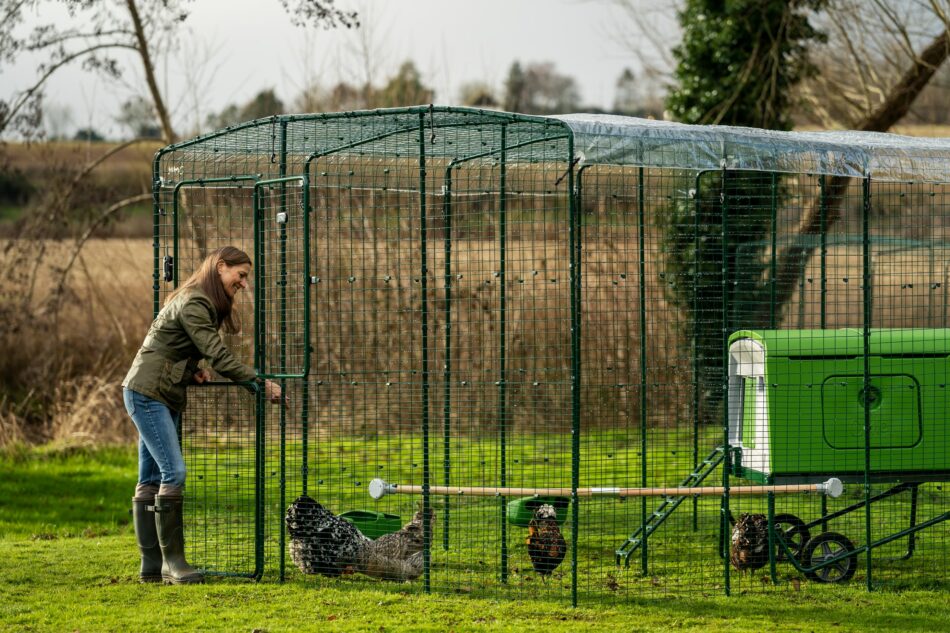

This entry was posted in Chickens

Summer is a great time to enjoy your chickens. But along with the summer fun comes sweltering heat and high humidity for many chicken keepers. Being aware of the signs of heatstroke in chickens can keep your flock safe and enable you to enjoy the warmer months along with them.
What is chicken heatstroke?
Heatstroke is what animals, including chickens, can experience when they become overheated to the point of it causing internal organ failure. Also known as heat exhaustion, heatstroke in chickens is more than just a hot hen — it’s the result of their body temperatures being elevated beyond a safe level for an extended period of time. Chickens that are too hot for too long simply can’t cool themselves anymore, and will succumb to heat exhaustion. When not treated properly and promptly, heatstroke can quickly become fatal to any affected hens. It’s important to help your chickens stay cool in the summer to avoid their body temperatures reaching this dangerous level.
Are any chicken breeds more susceptible to heatstroke?
Some breeds of chickens are more heat tolerant than others. The breeds that tend to not fare as well in hot climates are those that are bred primarily for meat such as Jersey Giants, and Delewares. Most egg-laying breeds of chickens do well in the hot weather as long as they have the right provisions — though some may need a little more support than others.
Silkies are a breed that doesn’t thrive in hot weather. This is largely due to their unusual feathers, as they can’t circulate air as proficiently as their regular-feathered cousins. Their head plumage can also obstruct their vision, making it more difficult for them to find water readily. Heavy breeds like Brahmas and Orpingtons may also struggle more in the heat due to their size.
Heat hardiness also depends on where chickens are raised. Hens that are adapted to the heat will fare much better than those that were relocated from a cooler climate to a warmer one. If you’re adding new chickens to your flock and experience intense heat in the summer, it’s best to obtain hens that are already accustomed to the warmer temperatures.
How to prevent chicken heatstroke
The old adage “an ounce of prevention is worth a pound of cure” is applicable when protecting your flock from heatstroke. One of the most important methods of keeping your hens cool in the heat is proper coop ventilation. Traditional wooden coops get stuffy and humid, keeping hens hot and uncomfortable. This can spell trouble quickly when the temperatures rise.
The Eglu Cube chicken coop by Omlet provides ample ventilation to move cooler air into the coop, which helps keep the internal temperature down. You’ll also want to provide as much shade as possible in your chickens’ run. This will help keep their body temperatures down, as well as keeping water sources cooler. Other preventative measures to combat heatstroke in chickens include:
- Providing plenty of fresh, cool water
- Letting your chickens dust bathe
- Offering frozen treats like corn or other chicken-safe vegetables
- Adding electrolytes to their water
- Frequently checking in on your flock to see how they are faring
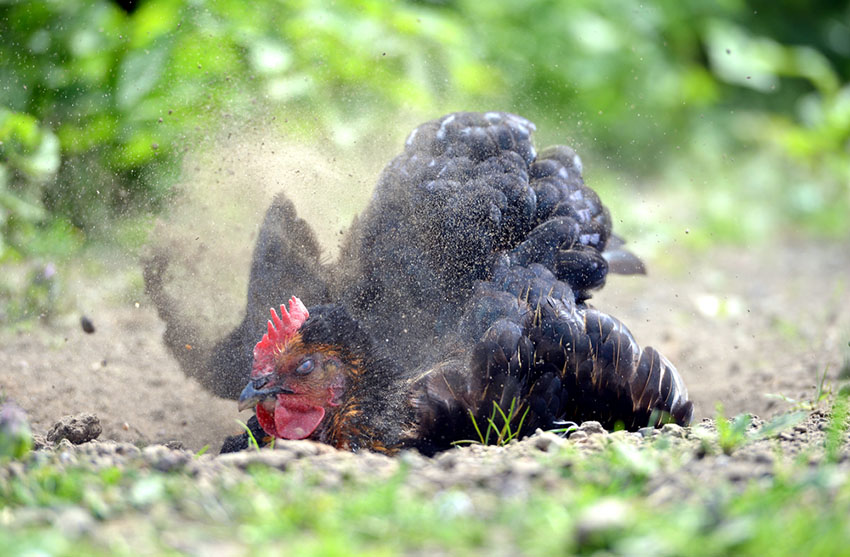
6 signs of heatstroke in chickens
Recognizing heatstroke in chickens quickly can make all the difference when treating it. Overheated chickens need prompt care in order to make a full recovery, so be on the lookout for the following signs of heatstroke in your flock.
1. Decrease in egg production
Chickens take their jobs of supplying eggs for your family seriously, so if they slow down or stop producing eggs then there is likely something amiss. Summertime is not part of a usual molting season for chickens — which is the only natural reason for young (non-broody) hens to stop laying eggs. You should investigate the cause of any decrease in egg laying by your hens, especially in the summer months, as this can be a warning sign to your flock getting too hot.
2. Lethargy
Hens that aren’t willing to move, seem dull, or appear sluggish should be evaluated for heatstroke. When hens are merely resting they will be stirred easily by food or human contact. Lethargic hens may be slow to respond or refuse to get up for food or after a gentle nudge from their owner.
3. Panting
The open-mouthed breathing associated with dogs is actually a cooling mechanism employed by chickens as well. While chickens may not loll their tongues out of their mouths, they will pant with their beaks open. Panting for short periods of time is a natural response to the heat, but keep a close eye on your flock if you notice panting. Offer cool water or frozen treats when you first notice them displaying this behavior.
4. Increased thirst
Are your flocks draining their drinkers? It’s good for chickens to drink more water during the summer, but make sure their waterers stay full and clean. Chickens can become dehydrated quickly on a hot day, and if their thirst can’t be slaked they will deteriorate rapidly. If you notice that you’re filling your flock’s drinkers much more often than usual, it could be a sign that they’re getting too hot.
5. Reduced feed intake
Healthy chickens also take eating very seriously. Any hens off of their feed need to be checked thoroughly. Make sure your chickens have access to quality laying pellets at all times, and offer frozen treats and fresh fruits and veggies often during the summer. Scratch grains are best offered in the evenings, as these grains increase your chickens’ metabolisms, which causes their bodies to heat up. The amount you feed your chickens should not need to be adjusted in the warmer months, and you can expect healthy hens to go through the same amount of feed as they normally would. Many animals (chickens included) will naturally eat less during the warm months, but it should not make a significant difference to your flock’s feeder.
6. Wings outstretched
Chickens don’t have sweat glands, so they have to find creative ways to expel heat from their bodies. Panting is one way, but stretching their wings or holding their feathers more erect is another. This allows more air circulation around their bodies and through their feathers in an effort to bring their core temperature down.
All of these symptoms can be signs of chicken heatstroke, but they can also point to other problems that can plague your hens. Familiarize yourself with chicken ailments so that you’ll be able to differentiate between conditions that may require different treatments.
How to treat chicken heatstroke
Preventing heatstroke in chickens is the best way to combat it. But, should you find any of your flock presenting with symptoms of heatstroke, you’ll need to act quickly. And, if the following actions don’t have your hen improving, it’s time to call your veterinarian.
First, you’ll need to move any affected hens to a cool, shaded area. It may be tempting to bring them indoors, but cooling them down too quickly can actually cause them to go into shock — which can be lethal.
If your hen is conscious and compliant, you can fill a bucket with enough cool (not ice-cold) water to submerge them from their neck down. It’s very important to not use very cold water, as cooling a hot hen down too quickly can cause them to go into shock, which is often fatal. After this brief soak, place the hen in a cool, shaded area until they are acting normally once again.
Omlet and keeping your hens safe
The Eglu Cube chicken coop by Omlet was designed to keep your hens cool in summer and warm in the winter. We want hens all over the world to be comfortable all year round. By putting chicken run covers over your flock’s outdoor space and providing them with the twin-insulated Eglu Cube, both you and your birds will be able to get back to enjoying a carefree summer.
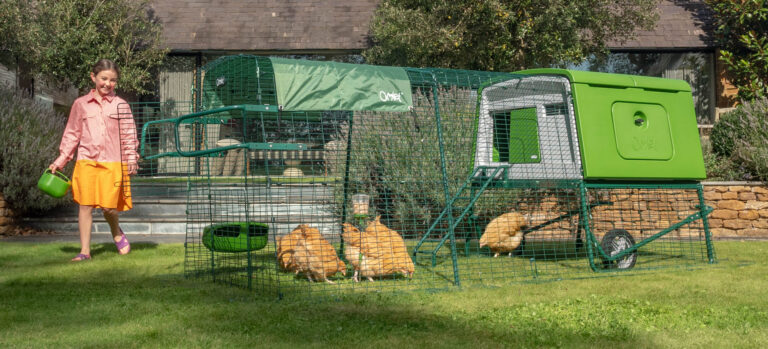

This entry was posted in Chickens

The best automatic chicken coop door is one that serves vital purposes. One that is programmable to fit your schedule, provides a layer of protection from predators, and opens horizontally with built-in safety sensors. See exactly how an Autodoor can revolutionize your chicken-keeping routine.
Why your chicken coop needs an automatic door
An automatic chicken coop door turns your ordinary coop into a technologically advanced smart hen house. Like a personal chicken coop concierge, the best automatic chicken coop door keeps your hens on schedule and protected while they roost. The addition of an Autodoor will:
There are different types of automatic chicken coop doors, but there’s a clear choice for the best option when it comes to flock comfort and safety.
The Best Automatic Chicken Coop Door from Omlet
The Autodoor by Omlet has been thoughtfully designed. Made of heavy-duty, rot and rust-free materials, it’s easy to clean and will last a lifetime. The ingenious horizontally opening screw-style gearing makes it incredibly difficult for predators to pry open.
Omlet’s Autodoor also increases the insulating effects of our Eglu Cube, and is designed to integrate into it seamlessly without having to remove the existing door. The Autodoor can also be installed on an existing wooden chicken coop, Omlet chicken runs, or on traditional chicken wire runs.
What do our ambassadors say?
Our Ambassadors are Omlet customers turned chicken keeping product experts.
They are on hand to answer questions on our Automatic door and to share their experiences of their Omlet journey and how they use our coops. You can locate an ambassador near you to get the answers that matter most to you and your flock.
Explore the best of the Autodoor
Light sensors for dawn/dusk automation
Want to sleep in or stay out late, but still have your flock tended to? The Autodoor can keep your hens on schedule based on the sun. And, since chickens seek out their roosting space based on the amount of daylight, you’ll never need to worry about changing the Autodoor’s settings when winter comes around. The various hours of sunlight during the year will prompt the Autodoor to close at the desired light level – no matter the season. And, the sophisticated Autodoor takes into account storms or overcast conditions, ensuring the door doesn’t close during brief fluctuations in lighting.
Set your own schedule
Some flocks roost at the same time each day rather than waiting for the sun to go down. If your hens prefer to turn in early, the clock setting may be the best option. Simply choose the designated time to open and close each day, and the Autodoor will see that your chickens keep to their schedule.
Install on both wooden & plastic coops
Additional fixings packs can be purchased to install the Autodoor on our plastic chicken coops, runs, or traditional chicken wire, making our door a universal fit. Install it on any existing traditional wooden chicken coop or Omlet chicken coop attached run – which makes it easy to transfer from a wooden coop to an Eglu Cube when you upgrade.
Predator resistant
The best automatic chicken coop door keeps your flock safe from chicken predators. By securing the coop door each night, your hens will be protected during the most active time for predators, like raccoons or coyotes.
Protecting your flock from raccoons poses a particularly difficult challenge, as they are very adept at prying doors open. However, the horizontal opening of the Autodoor is much more difficult to pry than other automatic chicken coop doors that open vertically. And, with the spiral gear mechanism instead of a pulley system, the Omlet Autodoor will stump even the most persistent of predators.
Reliable in heat & cold alike
Worried about the weather? The Autodoor withstands all weather conditions and temperatures. The door will still function in sub-freezing temperatures, effectively keeping your flock warm in the winter. With fewer daylight hours, your flock will stay toasty in their hen house until the desired daylight levels or scheduled time is reached. Additionally you can explore tips on winterizing your chicken coop to ensure it is ready for the colder season.
In the summer, the Autodoor will let your hens out during the cooler morning temperatures to help your flock through the warmer months. The longer daylight hours mean your chickens will be able to enjoy a breeze and shade outside of the coop for as long as possible. Yet, still being protected and kept comfortable at night.
Built-in safety sensors
Sophisticated safety sensors ensure your hens aren’t accidentally caught in the closing Autodoor. If any part of a hen is obstructing the Autodoor, it will re-open and attempt to close again a few minutes later. The gentle bump from the Autodoor is usually enough to get your hens moving if they’re resting on the threshold, and soon they’ll learn their schedule so they don’t dawdle at the door.
Pair your Autodoor with a coop your flock adores
When you pair the best chicken coop with the best automatic chicken coop door, you’ll ensure your flock has the absolute best setup. Our Eglu Cube coop and the Autodoor are made for each other!
The Autodoor installs quickly and easily on the Eglu Cube, without requiring any additional attachment kits. And, due to the integrated design, there’s no need to remove the existing swivel Eglu Cube coop door. In fact, the standard coop door can still be opened and closed separately from the Autodoor.
Omlet’s chicken coops are predator-resistant, dual-insulated, and provide optimum ventilation for your flock’s comfort.
The best chicken care with Omlet
Omlet creates the best chicken products available. Designed for a lifetime of ease and comfort, our chicken runs, chicken tractors, and hen houses set you up for success from the beginning and all throughout your chicken-keeping journey. Choose the best automatic chicken coop door and other poultry products from Omlet, and help your hens live their best lives.
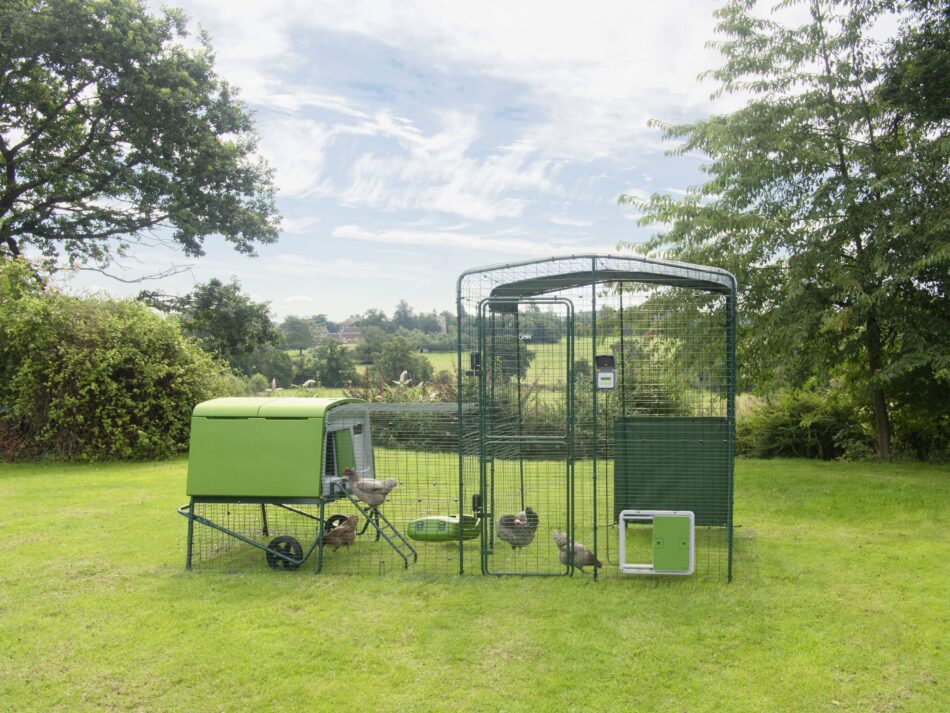
This entry was posted in Chickens

Daily chicken care can be an enjoyable activity. More of a hobby than a chore, caring for your flock should be something you look forward to every day. Chickens are relatively low-maintenance animals, but like all pets, require daily care to live their best lives.
Wondering what a day in the life of a chicken keeper looks like? We’ve compiled sample schedules that showcase how Omlet makes tending to your flock easy and enjoyable.
Morning chicken-keeping care
What if you could clean your chicken coop in the same amount of time that it takes you to prepare your morning cup of coffee or tea? With the Eglu Cube Chicken Coop by Omlet, you can! Your flock’s morning care routine couldn’t be easier or more efficient than with the Eglu Cube. Not only is our chicken coop easy to clean, but the included feeders and waterers hold plenty of sustenance for your flock to get them through the day.
Imagine if you will, a typical morning chicken care routine for a keeper with an Eglu Cube…
- Your day may start around 8:00 am. You’ll want to let your hens out to seize the day and open up their nesting partition door once they’ve vacated the coop.
- Then it’s time to clean the chicken coop out, but since you’ve got a sophisticated, easy-to-clean coop, it’s no problem. You’ll remove the droppings tray, and dump it in your compost pile or garbage.
- You’ll then want to spray or wipe the droppings tray and removable roosting rack clean if needed.
- Time to refresh the bedding in the tray, and replace the now-clean components back into the Cube.
- Finally, you’ll just need to top off your flock’s feeders and waterers for the day.
These tasks only take minutes for you to finish – likely before your coffee pot or tea kettle is done with your morning pick-me-up.
Afternoon chicken-keeping care
Your mid-day chicken check-in can be quick and easy. Hens usually lay eggs during the late morning and early afternoon hours, so mid-late afternoon is prime time for collecting cackleberries. The Eglu Cube has a convenient access door on the side that opens directly into the nesting area for quick egg-collecting.
Afternoon is also the perfect time to watch your hens in action. If you provide them with an assortment of chicken toys and accessories, you’ll be able to observe them play, peck, and perch throughout the day. Our customizable PoleTree Chicken Perch is perfect for your hens to catch a view of the world from an elevated place, or to take a quick nap in the afternoon sunshine.
When you head out to check for eggs, consider taking your flock a snack in the Caddi Chicken Treat Holder. This unique treat dispenser elevates snacktime and is great for keeping the floor of your flock’s run clean and tidy. Serve up fresh veggies or leafy greens to supply your chickens with enrichment and nutrition.
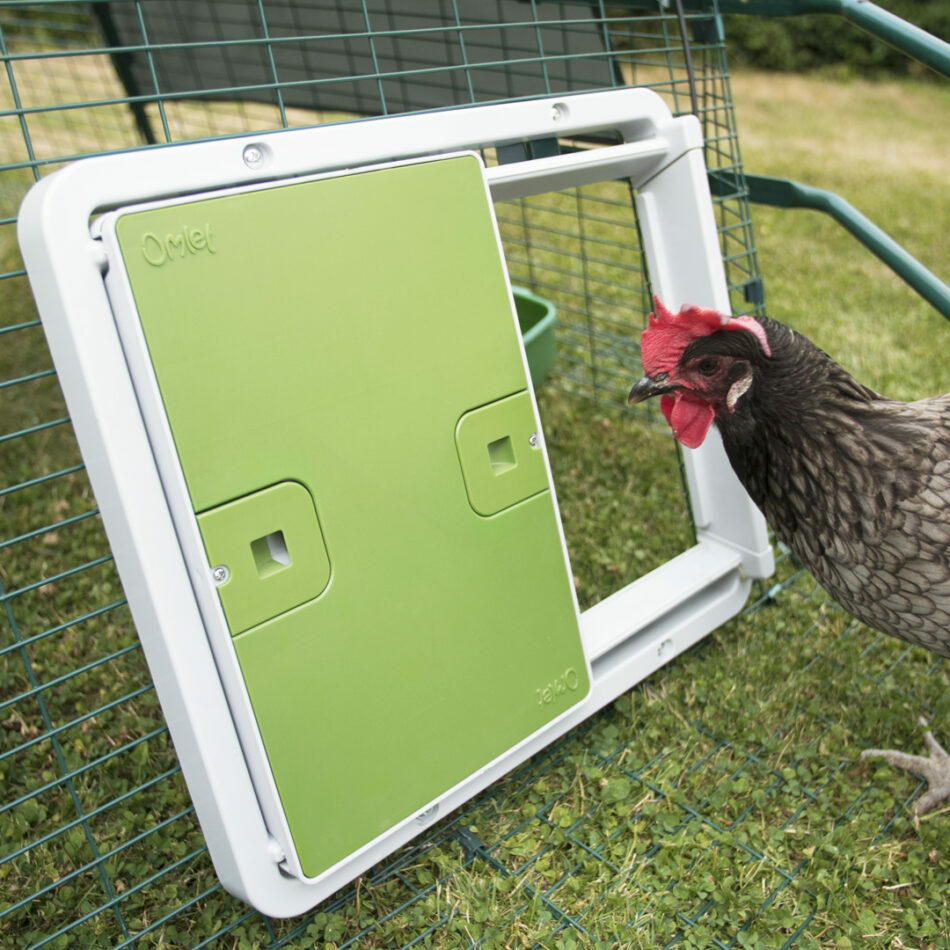
Evening chicken-keeping care
When daylight dwindles, it’s time to wrap up your flock’s day. For maximum safety, close the door to the coop overnight. If you aren’t home to tuck your hens in, consider adding an Automatic Chicken Coop Door.
The Autodoor in action:
- The Autodoor can be programmed with the clock or the sun to keep your flock on schedule – with or without you being home.
- Sophisticated safety sensors prevent the Autodoor from closing on any hens that are crossing or sitting on the threshold of the Eglu Cube.
- The sideways opening mechanism increases flock safety by making it difficult for predators to pry the door open.
Imagine how simple your evening routine would be with an Eglu Cube:
- You’ll close your hens in at dusk, or just after dark. If you’re using an Autodoor, you may just take a nice evening walk and check to make sure all of your hens made it in for bedtime.
- As a matter of personal preference, you may want to slide the nesting area partition door closed to prevent hens from roosting in it overnight.
- Finally, you’ll probably want to collect and store your flock’s leftovers to reduce raids from rodents.
And just like that, your flock is tucked into their comfy coop for another night of restful sleep.
Housing your hens in an Eglu Cube keeps them safe not just overnight, but during storms and predator attacks as well. But just how sturdy are Eglu Cubes? Strong enough to withstand attacks from a bear, hurricanes, tornadoes, and falling trees. Sleep easy at night knowing your flock is being fully protected when they’re secured in their Eglu Cube.
Omlet and chicken care
Omlet’s chicken-keeping experts have made tending to flocks easier than ever. Not only are our products safe and durable, but they’re easy to clean and a joy to use. Lighten your workload and treat your hens when you add an Eglu Cube, Autodoor, and PoleTree to your chickens’ setup.
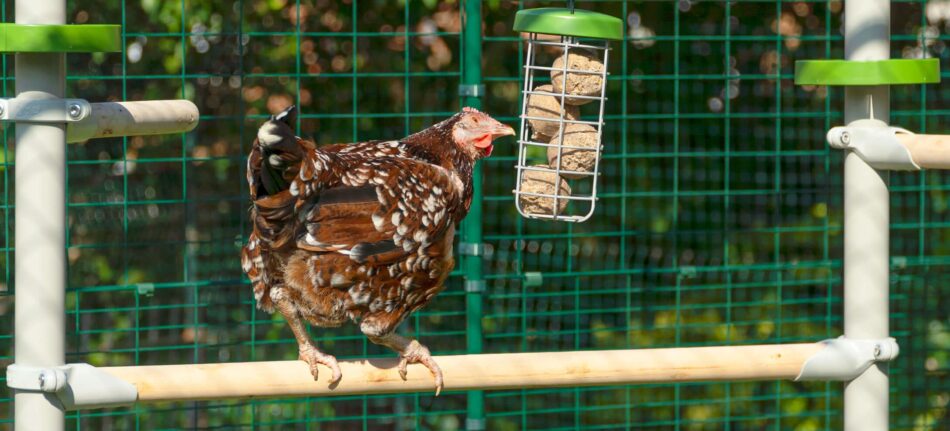

This entry was posted in Chickens
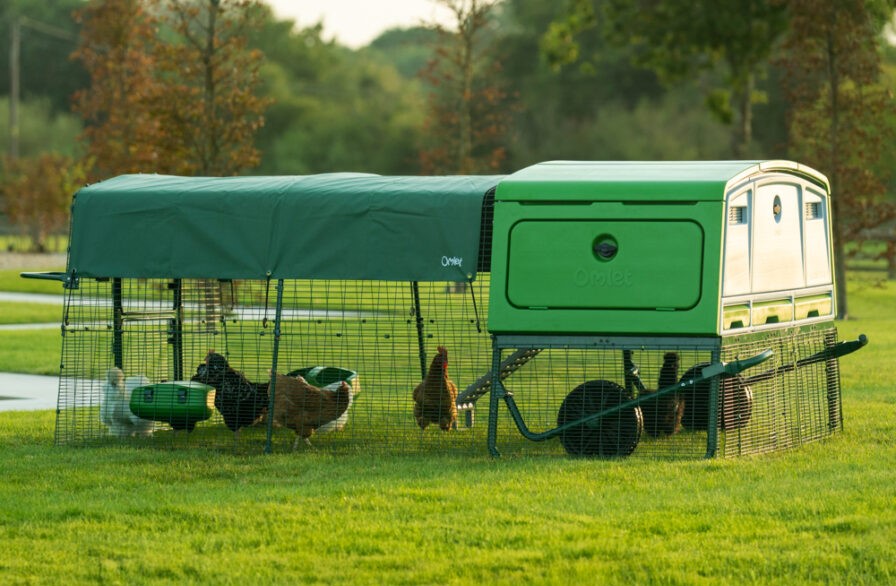
The right chicken coop size is crucial for every flock. Your hens’ home will need to safely and comfortably house them, and you’ll want to ensure that you have the correct size to accommodate your chickens. Appeal to all of the Goldilocks in your flock with our tips and coop sizing. Find the perfect coop size that’s not too big, not too small but just right.
The importance of the right chicken coop size
Chicken coop size is important because hens need adequate space to roost at night and lay their eggs. Chicken coops with dedicated egg-laying areas are ideal so that your hens have a place to rest and a place to nest. This keeps your eggs clean and free from being smashed by roosting chickens.
Your chickens’ coop should be large enough for your hens to feel comfortable and safe. Keep in mind that your hens’ house will mainly be used to sleep in at night and to lay eggs. Your hens will play, forage and be active outdoors, so their coop will only need to be large enough to maneuver into roosting or laying positions comfortably.
It’s also important to not get a coop that’s too large – especially in colder climates. Hens huddle together during chilly weather, and a smaller coop will help contain their body heat within. If you know that you’re limited to keeping 3 or 4 hens, it’s best to go with a smaller chicken coop. But if you plan to keep more than 4 hens, their body heat will fill the space of a larger chicken coop. To get you started, check out our backyard chicken coop and care guide.
How much space is needed per chicken?
There’s no exact formula for determining how much space to give chickens, and chicken coop sizes can vary.
Chicken Math
The phenomenon “chicken math” plagues most chicken keepers when trying to calculate coop size per chicken.
This is a term used when flock raisers acquire more chickens than they originally intended to. So, it’s always a good idea to get the biggest chicken coop you can for your space, should chicken math creep up on you.
As a general rule, you’ll want to provide your hens with as much space as possible. This will allow ample space for your existing flock, as well as room to grow.
Breeds
Different breeds of chickens have varying space requirements, and each individual hen will have their own opinion of how close they prefer to be during roosting.
Some breeds are larger than others so naturally a large chicken coop might be more beneficial to begin with – you can always add more coops in the future!
City or State Law
Some cities or states may require specific dimensions for your chicken coop based on the number of hens you have. Check with your city’s zoning department to see if there are chicken coop size requirements or restrictions before choosing your hen house.
What to consider when deciding the perfect size chicken coop?
The Essentials
Before settling on your chicken coop size, make sure you consider the following:
Coop Location
You’ll also want to consider if you want a mobile chicken coop or one that you’ll keep in a permanent location. Portable chicken coops are great for letting your chickens help mow your lawn, and are particularly helpful in areas that experience severe weather events. They can be moved to safety quickly and easily – while your flock remains safely inside.
Chicken coops placed in a permanent location will need a chicken run or chicken fencing to be attached to or placed inside. This will allow your hens time outside of their house in safety, and keep them from areas you’d rather not have them pecking around in.
First Time Chicken Keeping
Ultimately, choosing your chicken coop comes down to personal preference. Our beginner chicken coops are perfect for those starting out on their hen journey as they are easy to clean and maintain. Most chicken keepers would agree these are at the top of their list when it comes to selecting a chicken coop. At the end of the day, your ideal chicken coop size should be one that fits your needs and fits your flock inside.

How to find the right chicken coop size for your flock
If you’ve already decided on which breeds of chickens you’re going to keep, it’s time to determine how many you want to have. If your city or HOA has restrictions on how many hens you can have at any given time, then your decision is made for you.
There are still many different types and sizes of chicken coops to consider. Those with these restrictions can easily choose from our chicken coops for 2-4 chickens:
The Eglu Go
- Perfect for those needing a low-profile chicken coop
- Ideal coop that keep hens that prefer roosting at ground level
- Can also be used as additional housing for sick or injured hens
- Coop size dimensions: L = 9ft 6in, W = 5ft 5in, H = 2ft 7.5in (measurements include run)
The Eglu Go Up
- Ideal for those wanting an elevated coop
- Can be converted into a mobile chicken coop easily with the addition of handles and wheels
- Coop size dimensions: L = 7ft 2in, W = 4ft 9in, H = 3ft 8in (measurements include elevation above ground level)
The Eglu Cube
Larger flocks can be housed comfortably in one of our large chicken coops. The Eglu Cube is recommended for:
- Flocks of up to 10 small breed chickens
- Chicken keepers wanting to grow their flocks
- Both mobile and permanent setups
- Coop size dimensions: L = 7ft 7in, W = 5ft 1in, H = 3ft 10in (can be extended to 12ft with runs)
How to increase the size of your current chicken coop
At Omlet, we have firsthand experience with chicken math. Expanding your flock’s space will likely be an ongoing endeavor. After all, unless your city or HOA says otherwise, you can never have too many chickens.
Our walk in chicken runs can be extended indefinitely to accommodate your growing flock.
- Simply choose your ideal dimensions using our online configurator.
- Attach the corresponding run extension to your existing walk in run.
- Our attached chicken coop runs can also be extended to up to 12 feet.
- Place your order!
You may also wish to add extra chicken coops for sleeping and laying space within your growing run. The addition of any of our Eglu chicken coops will offer lodging to your growing flock. Create different areas of your chickens’ area with chicken run partitions, which can separate your flock by breed, size, or temperament. Our chicken coop ideas might help you settle on your next steps.
First-time chicken-keeping tips
Ready to get started keeping chickens? Once you’ve determined your coop size, here are some other things to check off before making the poultry plunge:
- Research what type of diet you will feed your hens. This could be regular laying feed, organic, non-GMO, or free-range pellets or crumbles.
- Decide if you want to start out with hens or chicks. There are pros and cons to each, but chicks will require additional equipment and care for the first 6-12 weeks of their lives.
- Prepare your yard and measure where you want your chicken flock’s home to be. This can help you determine if you would prefer a mobile or permanent setup.
The perfect size with Omlet
Choosing the chicken coop size that’s right for you is a big decision. But with Omlet, you can be sure that no matter the size of the coop, you’ll be getting a hen house or chicken tractor that’s been designed to last a lifetime. All of our chicken coops are built from the same heavy-duty, rot-free materials. Along with accessories to help your flock enjoy their space to the fullest.


This entry was posted in Chickens
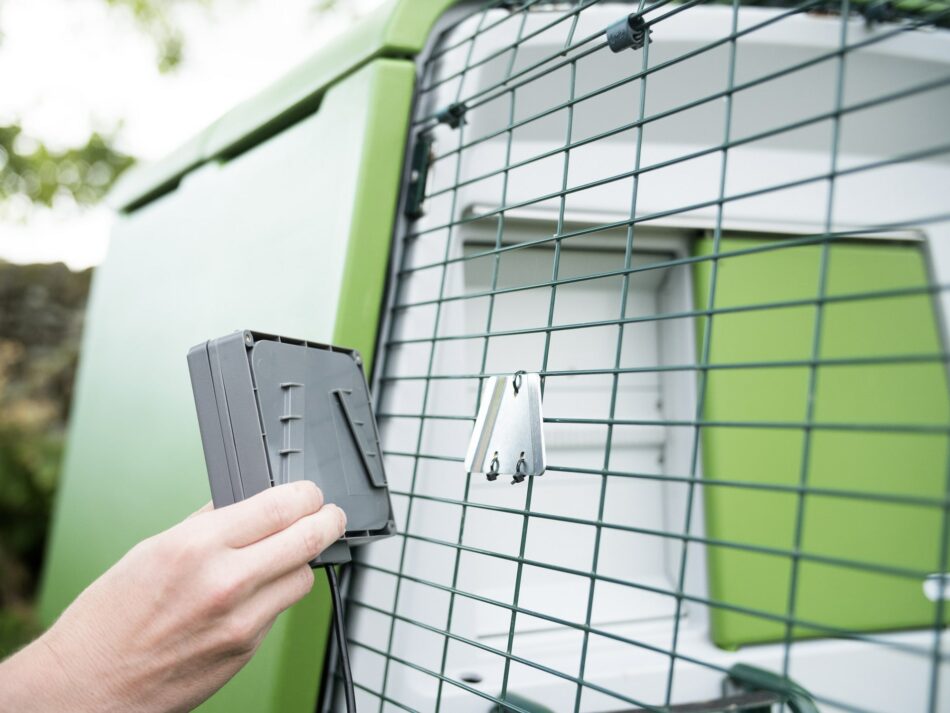
Have you considered reinforcing your flock’s setup and thought: are automatic chicken coop doors predator resistant? The short answer is yes, but not all automatic chicken coop doors are created equal. Adding an electronic door to your hens’ house can help prevent predator break-ins – if you choose the right one. We’ll highlight the distinctions between the types of automatic chicken coop doors, and why they make a difference in protecting your flock from unwanted visitors.
Why your chicken coop needs an automatic door
Automatic chicken coop doors offer an extra layer of security between your flock and the chicken predators that will try to break into their chicken coop. The doors can be programmed to close your flock in for the night, even while you’re away. In the morning, automatic chicken coop doors can let your hens out for you so that you don’t have to rise as early as your flock. Other benefits of an automatic chicken coop door include:
- Better chicken coop insulation
- Automation of your flock’s schedule
- Increased coop security to prevent accidental door openings
Technology has permeated the chicken-keeping world, making it more convenient than ever to care for your chickens. Automatic chicken coop doors are your first step in creating a smart chicken coop, allowing you more freedom and offering more security to your flock. But choosing the right automatic chicken coop door is important.
What makes an automatic chicken coop door predator resistant?
Automatic chicken coop doors are considered predator resistant because they have a motorized opening and closing method that make your chicken coop or chicken tractor more secure. Once closed, the gears that move the door hold it closed, making it more difficult to open from the outside. Good automatic chicken coop doors should create a seal once they’re closed, which also improves coop insulation.
Most automatic chicken coop doors open vertically. This poses two main issues:
- Vertically opening doors can be pried and pushed up by predators relatively easily. They use their paws and claws to create a gap along the bottom of the door, and are then able to push the door up and slip through.
- A coop door malfunction can cause the door to fall on one of your chickens, which can pin or seriously injure them.
Horizontally closing chicken coop doors are much safer for your hens. They’re harder for predators to pry open, and since they don’t rely on gravity or pulleys, won’t accidentally fall on your chickens.

Omlet’s predator-resistant Autodoor for hen houses
Omlet’s automatic chicken coop door (dubbed the “Autodoor”), was designed to give chicken keepers more freedom and peace of mind. The Autodoor tucks hens in for the night even when their owners aren’t home – ensuring they’re safe from predators that move in the cover of darkness.
The universal fit of the Autodoor allows it to be attached to any chicken coop or chicken run. This highly versatile design allows the Autodoor to be installed on virtually any setup. Install on an existing chicken wire run, wooden chicken coop, or on one of Omlet’s chicken runs by choosing from the appropriate installation kits. The Autodoor also integrates seamlessly with the Eglu Cube, without needing to remove the existing door.
The Autodoor is made from heavy-duty materials that are designed to last a lifetime, and opens on a horizontal coil mechanism. Once closed, the Autodoor keeps your hens safe inside their home from both predators and the elements.
Program the Autodoor with either a schedule based on light or a specific time. Most chicken predators are most active at dusk and shortly before dawn. The Autodoor can keep your chickens safely closed in their coop until the desired daylight or time has been reached.
Common chicken predators in the US
Depending on your area, some of the most common chicken predators flock raisers will encounter are:
- Racoons
- Foxes
- Coyotes
- Neighborhood dogs and cats
- Snakes
- Hawks
The most widespread and infamous chicken predators are raccoons and coyotes. They are found all across the US and are some of the most persistent and crafty of predators. Omlet has taken these (and other) predators into consideration when we designed our chicken coops, runs, and the Autodoor.
All of our chicken runs have anti-dig skirting to help prevent predators from tunneling in. And, the lower panels of the Eglu Cube’s attached run feature a tighter mesh to prevent raccoons from reaching through. And, new for spring 2023 are the t-locking handles that make the Eglu Cube even more raccoon-resistant.
Combined with the Autodoor, the Eglu Cube and its attached run is the best setup when creating a predator-resistant chicken coop, ensuring your hens stay as safe as possible from predators.
4 additional ways to protect your flock from predators
In addition to having a coop concierge to close your chickens in at night, you can take precautions to keep predators at bay. Make sure you have a strong chicken coop and a sturdy chicken run to house your flock. Additional considerations to make your setup predator-resistant:
- Install motion lights around the perimeter of your chickens’ space to scare off approaching animals
- Pick up any leftover chicken feed at the end of the day to avoid attracting rodents that may draw predators in
- Keep chicken feed in airtight containers
- Install hardware cloth around the bottom 4 feet of your chickens’ run
Protecting your flock with Omlet
Omlet’s chicken tractors and large chicken coops can be reinforced with the Autodoor to make them more predator-resistant. All of our hen houses have been designed with safety and functionality in mind. Have peace of mind while you sleep in, knowing that the Autodoor is taking care of your flock around the clock.
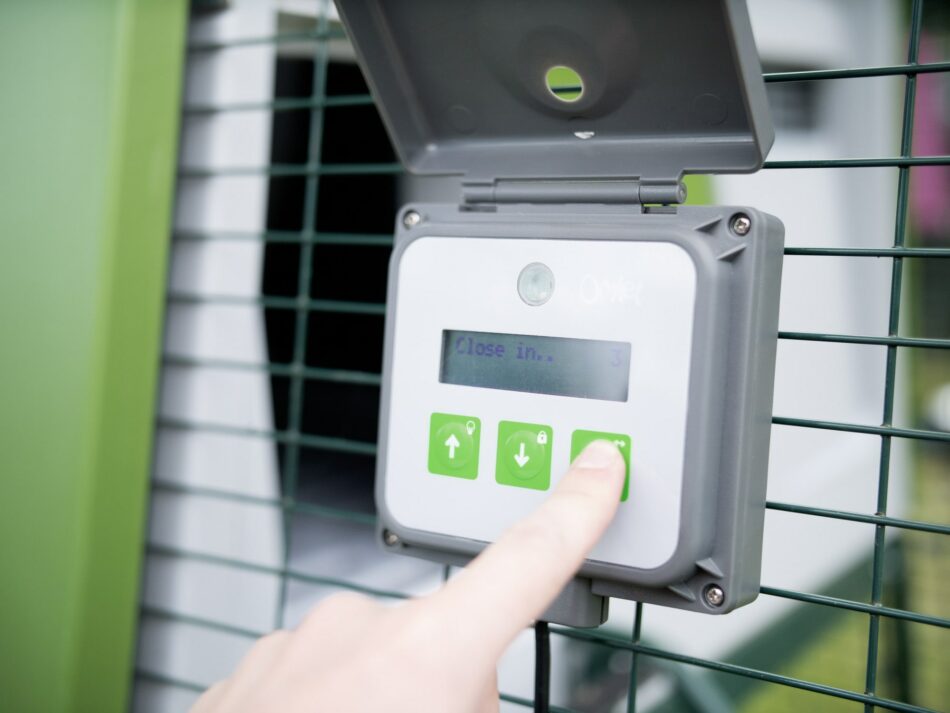

This entry was posted in Chickens
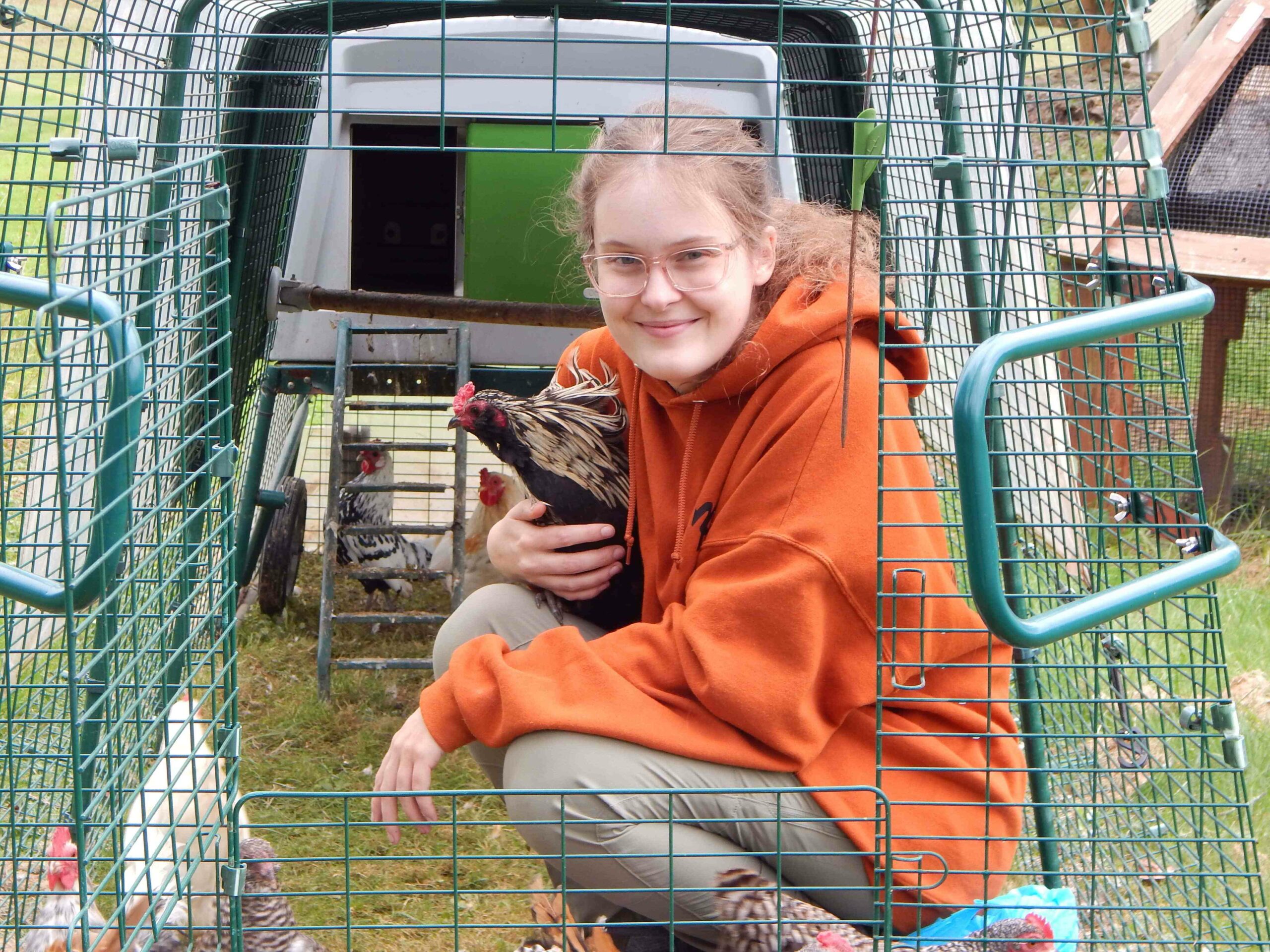
Rose is a chicken fanatic who’s been building her poultry empire since the tender age of thirteen. As an adult, she now turns her extensive poultry knowledge into how-to’s and guides for other chicken lovers, both young and old. Today, Rose owns and runs littleonionfarm.org, where she writes about self-sufficient lifestyles and shares her life on her Pittsburgh, PA, USA homestead.
Many people consider chickens to be the “gateway drug” to self-sufficient living, and for good reason. Chickens are easy to keep, easy to acquire, inexpensive (at least as far as livestock goes), and come with a variety of benefits. It stands to reason, then, that most chicken owners eventually get the itch to expand their flock once it’s established. This well-known phenomenon has come to be fondly known as “chicken math.”
Of course, some backyard chicken owners – myself included – don’t just stop with chicken math. Eventually, it becomes garden math, quail math, duck math, and then you end up with a homestead (I have no regrets).
Anyway, why would you want to expand your chicken flock? What kinds of benefits do chickens provide that would make you want more? And what can you do to prepare for when chicken math inevitably strikes?
Why chicken math?
Why do so many people end up buying chickens, only to end up expanding their flock later? I usually see a few recurring culprits that people fall victim to. The one that got me was the huge variety of chicken breeds available for us to enjoy. Chickens come in just about every shape, size, and color imaginable, and different breeds often have different personalities, too. My Golden Penciled Hamburg hen, for example, is on the flighty side – she’s not a cuddler – but she loves scratch grains with a passion, and has a particular appreciation for my Poppy Peck Toy.
Of course, the same things that make chickens a “gateway drug” also make expanding your flock easy – sometimes too easy. I started with a small flock of just eight hens when I was a child, which quickly became twelve hens… which then became a second chicken coop, and fifteen more chickens, and a few roosters… (you get the picture).
That being said, chicken math isn’t always a bad thing, as long as your birds (and you) continue to be happy and healthy. Your flock can become quite large before it becomes difficult, time-consuming, or expensive to care for. The cost of owning chickens does go up somewhat as you get more – especially food and housing costs – but I find that, even with a large flock, chickens’ cost of care exists in a “sweet spot” that makes them attractive for both experienced homesteaders and newbies alike.
Finally – on a more specific note – one of the most common reasons I see fellow chicken keepers expanding their flocks is because they want colorful eggs (or more eggs in general). While each hen will only lay one color egg her entire life, different hens can lay eggs in chocolate brown, medium brown, light tan, bright blue, sage green, dark olive, and, of course, white. Some hens even lay eggs verging on pale pink or dusky purple, but the exact color is heavily dependent upon each hen’s breed.
Chicken benefits (besides eggs)
The usual backyard chicken flock provides a few obvious benefits, the main two being eggs and meat. Many chicken keepers also enjoy the companionship and entertainment that their chickens offer. However, that’s not all there is to chickens – not by a long shot!
My main chicken coop is an Eglu Cube with wheels, so I move it around my yard to keep my coop cleaning duties minimal. However, I make sure to save any droppings from the enclosed portion to use for compost. Chicken droppings make a fantastic garden fertilizer, and even if you don’t plan to use them yourself, I promise that a local gardener will be thrilled to take any extras off your hands. Plus, with mobile chicken coops like the Eglu Cube, any manure that you don’t collect will fertilize your lawn. Your grass will grow back greener and fuller than it was before in places where your chickens have been!
Another lesser-known benefit to owning chickens is reducing your food waste. I care deeply about our planet, but even I end up with food that spoils on the counter or in the fridge from time to time. When that happens, my chickens happily break it down for me. Not only does it stay out of a landfill this way, but it adds variety to their diets and gives them enrichment, too.
Finally, chickens provide important pest and weed control to your backyard, especially if you allow them to free range. While a flock of chickens can’t mow your lawn on its own like a goat or cow might, most chickens will happily eat any critters they find in it, including ticks, grubs, earthworms, crickets, and sometimes even mice or snakes!
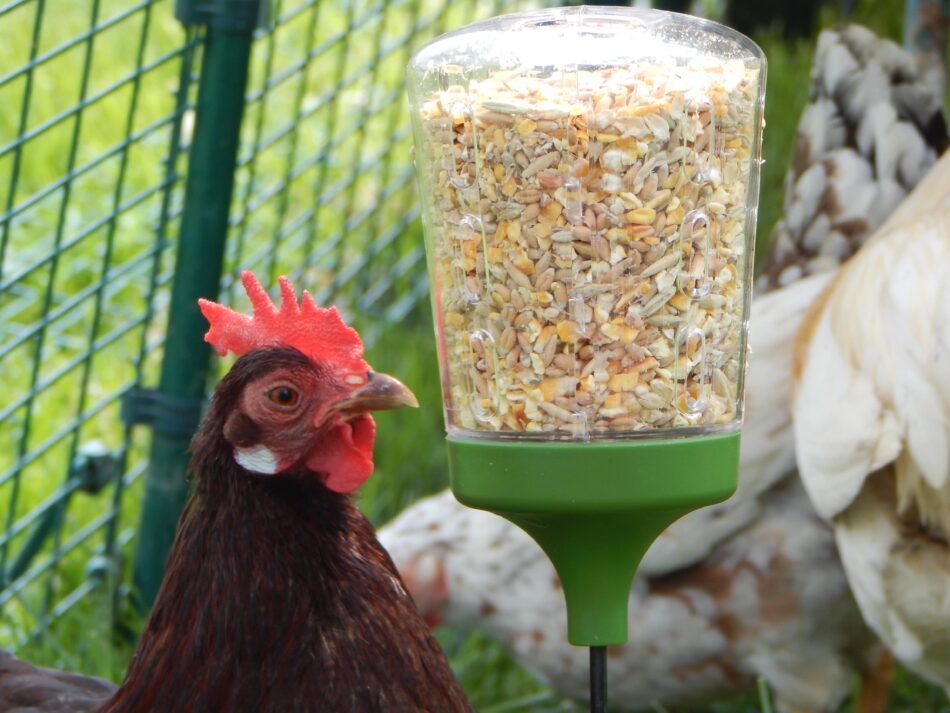
How to mitigate chicken math
What can you do to prepare for chicken math before it strikes? The main way is by buying a chicken coop that’s larger than you think you’ll need. For example, if you think you’ll only want four laying hens – a flock that would be small enough for an Eglu Go – consider upgrading to the Eglu Cube instead. This gives you room to add a few more in the future. At some point, you may still need to get a second coop (I know I did), but a larger coop will at least prevent that for as long as possible.
Another way to mitigate the effects of chicken math is by doing thorough research before you establish your first flock. I know it’s tempting to dive right in and order chicks as soon as possible, but I highly recommend taking a while to research breeds, coops, risks, and future plans before you get started. You can also avoid temptation by staying away from feed stores and poultry swap meets, but I find (from experience) that it’s smarter to plan for the inevitable instead of trying to prevent it!
Finally, make sure you’re familiar with any local regulations on flock size and composition in your municipality. I’m not familiar with other countries’ regulations but in the US state of Pennsylvania where I live, most livestock regulations are left up to the county to decide. However, townships and cities sometimes have their own rules for you to follow, too.
Final thoughts
Were you familiar with the concept of chicken math before reading this guide? More importantly, are you prepared for the moment chicken math inevitably strikes your flock? I’m a huge fan of Omlet’s Eglu Cube for newbie backyard chicken owners, so I never hesitate to recommend it – it’s the perfect size and configuration for a good-sized starter flock.
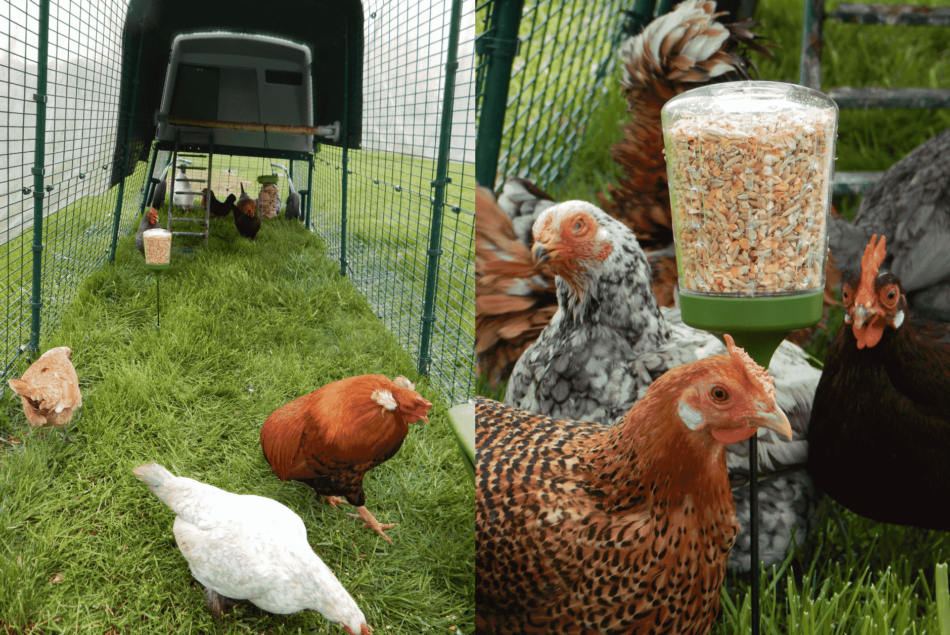

This entry was posted in Chickens
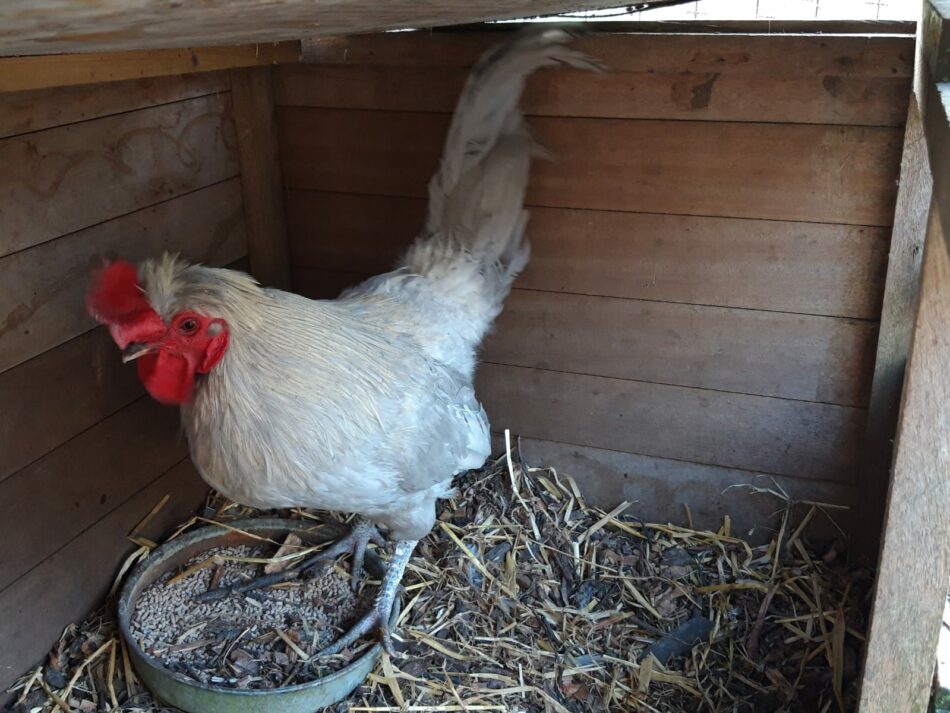
Wooden chicken coops have historically been the most common type of hen houses – but there are several reasons to avoid wooden chicken coops. Many types of wood are inexpensive and help lower the cost of a chicken coop. But, lower costs also mean lower quality. Over time, these cheaply made hen houses need replacing, which in turn costs you more money over the years. Thankfully, there’s an alternative to rickety, cheap, and hard-to-maintain wooden chicken coops. Don’t get caught in the vicious cycle of replacing worn-out wooden coops. Instead, invest in a plastic chicken coop that’s built to last a lifetime.
10 reasons to avoid wooden chicken coops
We’ve outlined the most common concerns when it comes to wooden chicken coops. And, when compared to plastic, there’s a clear winner.
1. Wooden chicken coops rot
Not all chicken coops are created to last. Wooden chicken coops, while less expensive to purchase initially, will eventually rot. Wood is a natural material that’s subject to the elements. Plastic chicken coops will never rot and don’t decompose the way wooden chicken coops do. Omlet’s chicken coops are designed to last a lifetime.
2. Wooden chicken coops are hard to clean
Have you ever scraped the inside of a wooden chicken coop with a putty knife or other flat-edged cleaning device? If you have, you’re not likely to forget it easily! And if you haven’t — you’ll want to spare yourself the experience. Removing droppings and thoroughly cleaning a wooden chicken coop is a very difficult task. Wood will rot faster if cleaned with a pressure washer, and takes hours to dry after getting wet.
Omlet’s plastic chicken coops are incredibly easy to clean. All of the interior pieces can be removed for easy cleaning, and the entire chicken coop is designed to be pressure washed or wiped clean. Get a sparkling clean chicken coop in just minutes with very little drying time.
3. Wooden chicken coops are costly to repair
Wooden chicken coops start to deteriorate as soon as they are exposed to the elements. Their roofs will need shingles replaced, as will rotted or warped boards. Chicken wire or hardware cloth will come loose from staples anchored in flimsy wood and will need to be reinforced. A lot of routine maintenance goes into keeping a wooden chicken coop structurally sound.
Plastic chicken coops require no maintenance or upkeep. Omlet’s chicken coops are easy to assemble, and don’t require replacement parts.
4. Wooden chicken coops aren’t predator-resistant
Chicken predators are something that all flock raisers will encounter at some point. One of the most common and conniving of these predators is raccoons. Wooden chicken coops are no match for the crafty methods of these masked chicken bandits. Raccoons are notorious for reaching through openings, and gnawing or pushing their way into hen houses and chicken runs.
While wood weakens over time, plastic chicken coops will hold up over the years — making them much more resilient. Raccoons in particular will exploit any weak spots in your chicken coop or run, so the best way to make your chicken coop raccoon-resistant is to invest in a strong setup.
Add another layer of security to your hens’ home with an automatic chicken coop door. Omlet’s Autodoor opens and closes on a horizontal spiral mechanism that is extremely difficult for predators to pry open. And, with the light and time settings, your flock will be safely closed in each evening before predators are at their most active.
The Autodoor is designed to integrate seamlessly with the Eglu Cube chicken coop, but can also be added onto any chicken run through one of our attachment kits.
5. Wooden chicken coops aren’t waterproof
Wood is porous and gets saturated when it rains. Not only does this lead to rotting, but it also creates breeding grounds for mold and mildew. Spores from these fungi can spell respiratory problems for your flock, and create very unpleasant living conditions.
Omlet’s coops are waterproof and won’t mold, mildew, or rot as a result of rain. And, additional chicken run weather protection will keep your flock stay nice and dry on rainy days in their run. Chickens can enjoy rainy days when they’re covered and have a dry coop to roost in.
6. Wooden chicken coops aren’t insulated
One of the biggest issues with wooden chicken coops is their lack of insulation. Drafty chicken coops can be deadly during winter storms, and downright scorching in the summer heat. Without insulation, your hens’ house will fluctuate wildly along with the weather.
Omlet uses twin-wall insulation methods in our chicken coops to ensure ultimate comfort. Our line of Eglu chicken coops help keep your hens cool in the summer and warm in the winter.
7. Wooden chicken coops have a short lifespan
Replacing your chickens’ coop every few years sounds like a costly endeavor, right? But it’s exactly what you’ll be doing with wooden chicken coops. The best chicken coops are designed to last a lifetime, and can grow with you and your flock.
Omlet’s chicken coops aren’t just long-lasting but have attached runs that can be extended to up to 12 feet long. They also integrate seamlessly with our heavy-duty walk in chicken runs, which can be extended indefinitely.
8. Wooden chicken coops let mites thrive
Mites are a nightmare for chicken keepers and hens alike. They make your flock feel miserable, and are hard to eradicate, as they thrive in moist, dark crevices. Mites are easier to prevent than to treat, and one of the best ways to avoid mites in the first place is to create an inhospitable environment for them.
Avoid mites by investing in a plastic chicken coop. Regular pressure washes or wipe-downs will prevent the presence of these parasites and give your flock a much more hygienic environment.
9. Wooden chicken coops are hard to move
There’s a sense of finality when you set a wooden chicken coop in its place. Once erected, a wooden coop cannot be moved easily. Whether it be from rot or weight from being rained on, wooden chicken coops are not meant to be relocated.
Some wooden chicken coops claim to be chicken tractors (mobile chicken coops), but due to their deterioration in the elements, they become increasingly difficult to move.
Our mobile chicken coops are designed to be moved as often as you’d like, and can be moved with ease by just one person. All of our coops can have wheels and handles added to make moving them a breeze. Their structural integrity holds up against the elements, so you’ll never need to worry about them falling apart.
10. Wooden chicken coops are flimsy
Wooden chicken coops are no match for wild weather events or large predators like bears or coyotes. During storms, roofs can be blown off and boards loosened by battering wind and rain. Predators can easily push through chicken wire or dig under runs.
Omlet’s Eglu Cube chicken coop is strong enough to withstand hurricanes, bear attacks and falling trees. And, all of our chicken runs are made from heavy-duty wire-welded panels that feature anti-dig skirting to help prevent predators from digging into your chickens’ space.
Omlet’s Eglu Cube chicken coop
The winner is clear: the Eglu Cube chicken coop, exclusively by Omlet. But don’t just take our word for it — see why thousands of chicken keepers across the globe trust the Eglu Cube with their flocks. Plus, the Eglu Cube is backed by our 10 year worry-free warranty, and a 180 day money back guarantee. When you choose the Eglu Cube, you’re investing in the only chicken coop you’ll ever need to buy.
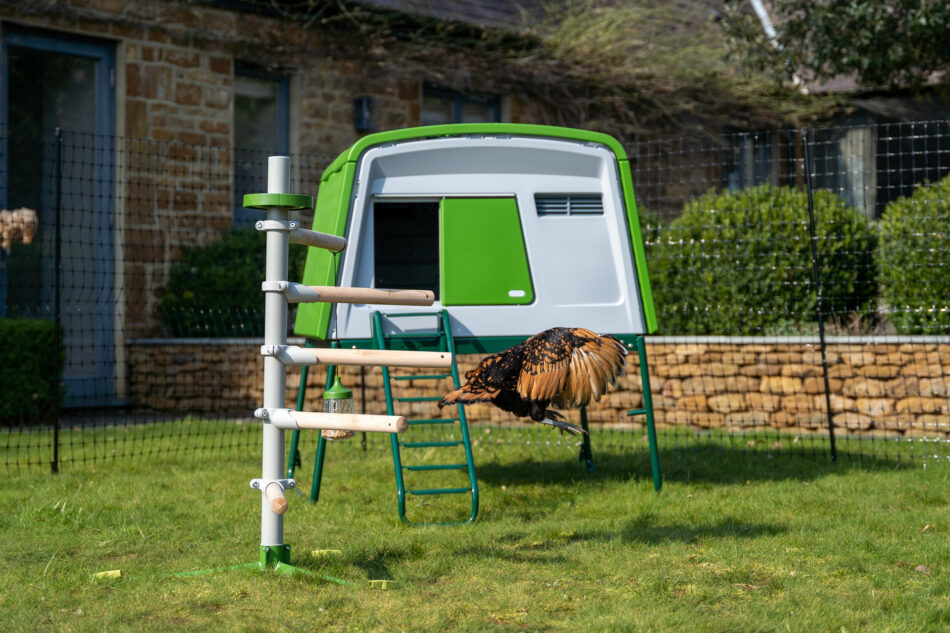
Omlet’s plastic chicken coops
Like all Omlet chicken coops, the Eglu Cube has been designed to outlast and outperform wooden chicken coops. With the addition of the Autodoor, your Eglu Cube will be a force to be reckoned with — deterring persistent predators, parasites, and perilous weather conditions. Invest in your flock’s future when you choose an Eglu Cube, and never worry about having to repair or replace your chickens’ coop.
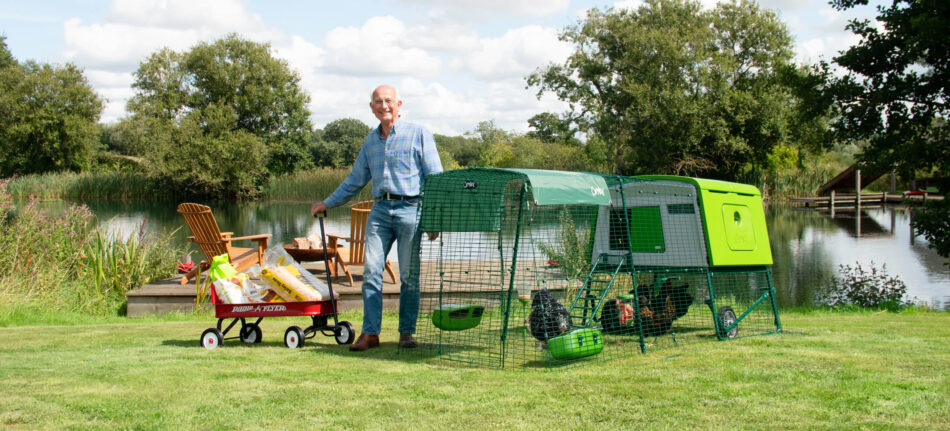

This entry was posted in Chickens

June 1st marks the beginning of hurricane season in the US. If you live along the coast, you’re probably familiar with these hurricane preparation steps: putting fresh batteries in flashlights, stocking up on non-perishable food items, making sure your car’s gas tank is full, filling water jugs and bottles, and maybe even investing in a generator. But are you preparing your chickens for hurricane season?
It’s important to have a plan if and when a hurricane strikes. This includes planning for your family, indoor pets, and outdoor pets. Thankfully, there are easy steps that you can take to make sure your chicken weather hurricane season along with you.
4 Hazards of hurricanes to chickens
Hurricanes bring a whole host of severe weather conditions – many of which can be very hazardous to your hens. Electrical outages, water shortages, and decreased mobility all add to the difficult situations that come along with hurricanes. Get ahead of the storm and prepare your chickens for hunkering down during a hurricane.
1. Supply shortages and hazardous driving conditions
Stock up on your flock’s feed well before the storm is anticipated to make landfall. Suppliers may not be able to make deliveries to stores as the storm grows stronger, so keeping an extra bag or two of feed at the beginning of hurricane season is a wise investment. You may also want to keep reserves of bedding in your supplies so that you don’t have to brave the roads in search of shavings or straw. Keep empty drink containers to refill with drinking water for your hens, or purchase containers to store water in.
2. High winds
Wind gusts of over 75 mph are common during hurricanes and tropical storms, and in the case of category 3 hurricanes and higher, can reach speeds of over 100 mph. If a hurricane does not warrant evacuation, your hens should be firmly secured inside of a strong chicken coop. Tethering your hens’ house to the ground through the use of ground rods such as t-posts and tie-down straps will help prevent movement during high winds.
3. Heavy rainfall and flooding
Make sure your chickens have an elevated chicken coop to escape to during heavy rainfall. It’s common for hurricanes to cause flooding – sometimes in the form of flash floods. Giving your hens plenty of chicken perches inside of their run will give them a safe place to escape from rapidly rising water. Adding weather protection to your chickens’ run will help abate the accumulation of rainfall.
4. Tornadoes
Similar to high winds, tornadoes can topple chicken coops or even toss them around your yard. Tornadoes are common events during a hurricane or tropical storm and can form quickly. In addition to making sure your chicken coop is tethered to the ground to prevent it from being overturned, keep your chickens’ coop away from trees or powerlines that could potentially fall. Mobile chicken coops are particularly helpful for sudden weather events, as they can be moved to safety quickly on short notice.
Weatherproofing your chicken coop for a hurricane
Hurricanes typically come with advance warning, but you’ll need a plan to put into action once a hurricane warning has been issued. Many of these modifications can even be made at the start of hurricane season to avoid having to frantically prepare your flock when the weather turns wild.
Temporary chicken housing
If you have an old wooden chicken coop vs a sturdy plastic coop, relocating your chicken flock to a safer space may sometimes be the best option in preparation for a hurricane or tropical storm. A garage, shop, or sturdy shed can house hens that are displaced due to weather conditions. Be sure all hazardous materials are out of your flock’s reach, like:
- Electrical cords or wiring
- Pesticides, weed killer, antifreeze, motor oil, or other liquids
- Exposed lawn mower blades or other sharp lawn care instruments
Or, in an emergency, you may need to temporarily house your chickens in your home. An enclosed space that’s easy to clean like tiled rooms or areas are ideal temporary housing for chickens. A playpen designed for small animals can keep your hens contained to a desired area of your home.
Chicken tractors for easy relocation
Our chicken tractors are mobile chicken coops that are designed to be moved quickly and easily. For chicken keepers living in regions that frequently experience severe weather, mobile chicken coops offer the best flexibility for your flock. Simply engage the wheels on each side, then roll your hens’ entire home to safety. This could be in a garage or shed or another sturdy structure, to higher ground in the case of flooding, or simply out of the trajectory of trees or power lines that could potentially fall during a hurricane.
Fortifying stationary coops
The best option for flocks that will be staying put during a storm is the Eglu Cube Chicken Coop. Heavy-duty and waterproof, our largest chicken coop can keep your hens safe during perilous times. These strong chicken coops have withstood hurricanes, tornadoes, falling trees, and other wild weather events.
Fortify your flock’s Eglu Cube with an Automatic Chicken Coop Door by Omlet. The horizontal opening and closing mechanism operates on a spiral gear system, which makes it incredibly difficult to pry or force open. The audible seal, once the Autodoor has closed, lets you know that your hens are safe inside their reinforced coop.
If your coop and run will be staying put, add screw pegs along the bottom of the run to help hold it down during high winds. For excessive wind speeds, use tie-down straps to anchor your Eglu Cube to the ground. T-posts, fences set in concrete, or buildings with foundations make good anchor points for straps.
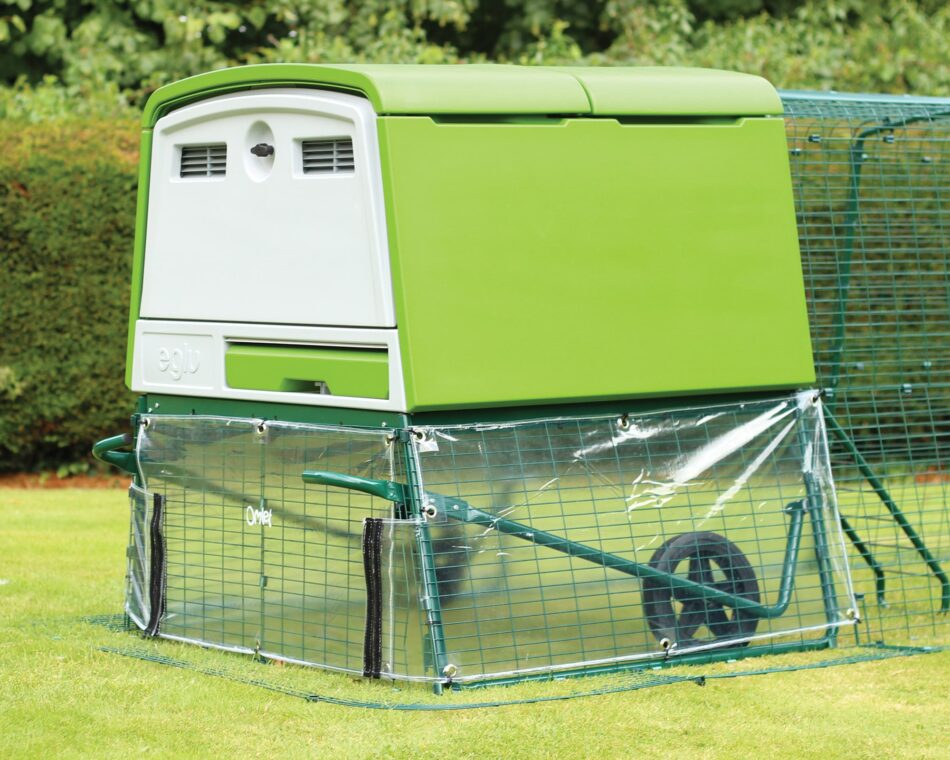
Evacuation planning
Sometimes it’s safer to evacuate in preparation for a strong hurricane. Evacuations can be voluntary or mandatory, but whatever the case may be, you’ll need to have a plan for your flock. A mobile chicken coop can be easily rolled onto a small trailer or truck to be relocated. Or, you can quickly disassemble your Omlet chicken coop to take with you. Your Eglu coop can then be easily reassembled once you reach your destination. Chicken fencing is also quick and easy to take down and reassemble to give your flock some space once you arrive.
Hens can be transported in dog kennels, but take care when using wire kennels, as your chickens’ legs may get caught. The best kennels to use are those with plastic floors and sides. Rabbit cages are also suitable for transporting hens.
5 hurricane essentials to bring with you:
- Feed and feeders
- Water and waterers
- Housing (either their regular coop, or temporary accommodations)
- Additional bedding for their coop
- Chicken supplements to help combat the stress of relocating
After the hurricane
After the storm has passed, it will be time to assess the damage. First, check in with your chickens if they weathered the storm in their coop to make sure none of them sustained injuries. Contact your veterinarian right away if you suspect any illness or injury resulting from the stress of the storm.
Carefully remove debris from your yard or anywhere that your chickens have access to. Broken glass or garden decor, metal, screws, nails, or any other sharp objects should be removed before letting your chickens back out. Check to make sure your chicken run is still securely anchored into the ground, and that all of the clips are still intact.
Offer your flock food and water as soon as they are let out of their coop. The sooner they can get back into their regular routine, the sooner they will unwind from recent events. A stressed-out chicken may not want to eat right after being let out of the coop, but check in with your hens to make sure they are back to eating and drinking within the next several hours. You may also notice a decrease in egg production in the days following a stressful event like a severe storm, which is completely normal.
Be extra vigilant after a severe storm, as wildlife can be displaced during the chaos. Chicken predators like foxes, coyotes, raccoons or stray dogs and cats may find themselves closer to your flock than before as a result of fleeing rising waters or high winds, and will be in search of an easy meal. Rodents will also be on the lookout for seeds and feed they can swipe, so pick up any leftover food from your flock for several days following a storm.
Omlet and chicken care
Omlet makes preparing your chickens for hurricane season less stressful. Give yourself peace of mind when you get your hens a strong, capable coop to help them weather the storms. Whether you ride out the storm at home, or evacuate to temporary accommodations, our expertly designed Eglu Cube and Autodoor will have your hens hunkering down safely during hurricanes.
This entry was posted in Chickens
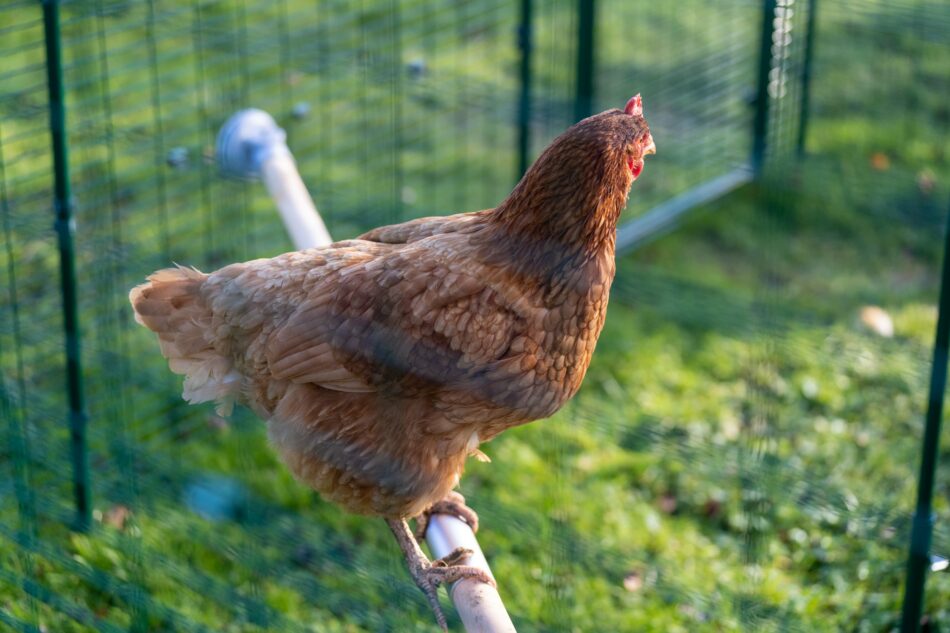
Backyard chickens have been rising in popularity over the past several years. Once viewed as farm animals, chickens are now gracing the backyard of many families living in suburban areas. If you’ve been curious about starting your own backyard flock of chickens, we’re here to equip you with knowledge and products to make keeping chickens a success.
4 reasons to keep backyard chickens
Keeping backyard chickens is a great hobby that can be shared with the entire family. The relationship between hens and humans is very symbiotic. Chickens are prey animals that need protection from predators, and when provided with care and shelter can thrive in virtually any setting. Hens offer humans companionship, backyard pest control, and of course – fresh eggs.
Having chickens in your backyard will:
- Provide your family with fresh eggs year-round
- Reduce stress through more screen-free time spent outdoors
- Be a unique pet experience for you and your family
- Teach the value of work and responsibility to children
Backyard chicken keepers enjoy watching their flock simply peck the ground and go about their daily routine. You’ll be amazed by how even a small flock of hens can decimate the population of pests like ants, spiders, snails, and even scorpions. All that added protein gets converted into delicious and nutritious eggs for you to collect from your chickens’ coop daily.
How to choose your backyard chicken coop
Backyard chicken coops are the most important component of owning hens. Your hens’ home will need to shelter them from the elements and predators, offer a safe place to lay their eggs, and keep them comfortable in all seasons. And as their caretaker, you’ll be spending time cleaning and maintaining your flock’s coop. Your choice of a chicken coop can be the difference between backyard chicken keeping being an either enjoyable hobby or a dreaded chore.
When choosing your chicken coop, determine:
- Whether a wooden or plastic chicken coop will suit you best
- Whether or not you need a mobile chicken coop
- How much space you have
- How much time you’d like to spend cleaning and maintaining your coop
- The amount of time you’d be willing to spend assembling a chicken coop
Find your perfect backyard coop with Omlet
Omlet chicken coops: what backyard chicken keepers’ dreams are made of. Truly incredible hen houses, our coops keep your flock healthy and happy, while cutting down on your workload. Omlet chicken coops:
- Can be converted into mobile chicken coops
- Feature twin-insulated walls to keep your hens warm in the winter and cool in the summer
- Have unique safety features like a pull-and-twist coop door opening mechanism and predator-resistant access door handles
- Are made from heavy-duty plastic that will never rot
- Take only a few minutes to clean thoroughly
The best chicken coops are those that bring joy to both flocks and their keepers. From our chicken tractors to our large chicken coops, there’s an Omlet coop for everyone to start enjoying raising backyard chickens.
What chicken run should I get for my flock?
Flocks forage and roam by nature, but having a backyard chicken run will not only help keep your hens close to home, but also away from potential danger. From plants toxic to chickens to neighborhood dogs and cats, containing your chickens in a run is the best way to keep them out of harm’s way.
When choosing a run for your chickens, aim to offer the most space possible. Omlet’s walk in chicken runs provide full protection from predators with roof panels and anti-dig skirting. Our runs can also be extended as your flock grows to give them plenty of room.
If a chicken run isn’t feasible for your space, chicken fencing is another option to contain your flock. Our flexible chicken fencing can be adjusted to any shape and can be attached to a wall or with repositionable posts. And, with easy-access gates, you can enter and tend to your flock.
Is it legal to keep hens in the backyard?
Laws vary between states regarding keeping backyard chickens, but most states leave the decision up to individual cities or homeowners associations (HOAs). Before you buy a backyard chicken coop and obtain hens, you’ll need to check with your city zoning office or HOA to get permission. Any laws about keeping chickens will likely be in regard to:
- The number of chickens you can keep
- Your backyard chicken coop location, size, or type
- Restrictions on owning roosters
Your chickens’ coop will most likely need to be kept a certain distance from your house or other homes. Ask if this restriction applies to your backyard, and keep the distances in mind even with mobile chicken coops.
The best backyard chicken breeds
The best backyard chicken breeds are those that are able to best tolerate your climate and lifestyle. Chicken breeds vary widely, and have tendencies such as temperament and behavior specific to their breed. Breeds to consider keeping in your backyard include:
Large breeds such as Brahmas or Jersey Giants can also make good choices in a backyard chicken flock as they are too heavy to fly long distances and are resilient in most climates.
Once you’ve decided on the breeds you’re interested in keeping, you’ll need to see where you can find your chickens. You can find a local breeder to help you obtain your chicks or hens. Chicks can also be obtained from most feed stores in the spring and summer months.
Tips for caring for & protecting your new flock
Keeping backyard chickens healthy and happy can be accomplished by caring for your hens on a daily basis, and providing them with protection, entertainment, and enrichment. The care that your backyard chickens will need includes:
- Feeding them a high-quality layer pellet diet
- Keeping fresh water available at all times
- Cleaning their coop thoroughly several times a week
- Protection from predators
It’s also good to offer opportunities for your hens to entertain themselves in an enriching way. Our line of chicken toys and accessories will ensure that your flock is never bored. Encouraging your flock to be active is particularly important during the colder months.
Seasonal changes are easy to prepare for with Omlet. Our chicken weather protection offers shade from the sun, shelter from wind, rain, and snow, and helps prevent hazardous living conditions for your backyard chickens. In sub-freezing weather, extreme temperature jackets for chicken coops can be added to your hens’ home for additional insulation.
How Omlet backyard coops defend against predators
Omlet’s chicken runs all come standard with anti-dig skirting to help prevent predators that aim to tunnel into the run. Our Eglu Cube chicken coop features t-lock handles on the exterior coop access doors and smaller mesh spacing along the bottom panels of the attached run to prevent reach from predators such as raccoons. Other chicken predators we’ve designed our coops to thwart include:
- Foxes
- Coyotes
- Hawks
- Snakes
- Raccoons
- Neighborhood cats or dogs
Installing an automatic chicken coop door adds an additional layer of security to your coop. The horizontal opening and closing mechanism is extremely difficult for prying paws to open. Securing your hens in their backyard chicken coop each night will bring them a better night’s rest – peace of mind for you.
What to avoid when backyard chicken keeping
Some additional thoughts to keep in mind:
- Never leave free-roaming hens unsupervised
- Don’t forget to find a chicken sitter if you’ll be away from home for more than a day or two
- Slowly introduce other pets like dogs or cats to your hens to prevent startling or injuring them
- Select a vet that treats poultry ahead of time in the event of illness or emergencies
Above all, don’t take the plunge into poultry before you’ve assembled your chickens’ coop and run and become familiar with using them. Omlet’s chicken coops and runs come with everything you need to safely keep chickens as soon as our products have been assembled – so be sure to follow our step-by-step instructions to completion before obtaining your hens.
Backyard chicken keeping with Omlet
Raising backyard chickens is a rewarding journey – start strong with products that will last a lifetime. Our chicken coops protect thousands of flocks in backyards all over the world. Customize your yard or chicken run with unique products like the Chicken Swing and PoleTree Customizable Chicken Perch for a truly one-of-a-kind experience. At Omlet, we’ve created the best products to make keeping chickens in your backyard not only a reality but a success.

This entry was posted in Chickens
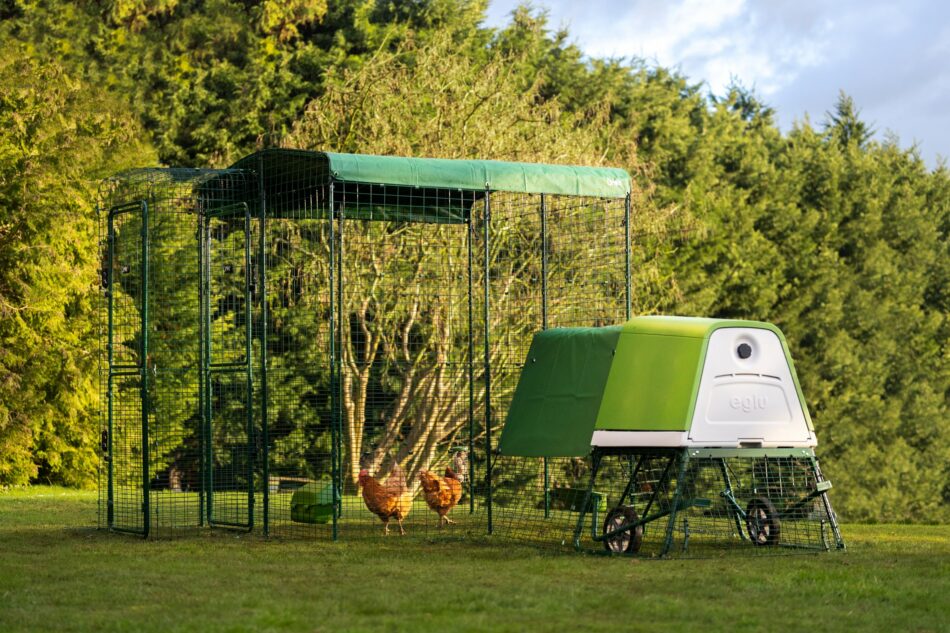
Looking for a beginner chicken coop? The best chicken coop for beginners are those that can grow along with flocks and their keepers – making it the first and last chicken coop you’ll need to buy. There’s a lot hinging on your hens’ home: their health, safety, and comfort. You’ll also want a coop that is easy and quick for you to clean, and is enjoyable to use. Omlet has the coops to check all of those boxes – and more.
The best Omlet chicken coops for beginners
The best chicken coops grow with their flocks and keepers’ level of experience. And, the best beginner chicken coops are easy to use from the start, but also functional and practical enough for even the most advanced chicken keeper.
We’ve made keeping chickens easy for all ages and stages of flock-raisers. Omlet’s line of Eglu chicken coops not only provide superior safety and comfort to the hens they house, but also allow owners to spend less time cleaning and worrying and more time enjoying their flock.
All of our coops are:
- Easy to build
- Simple to clean
- Predator resistant
- Have the ability to be mobile with the addition of our wheels and handles kit
- Are twin-wall insulated, keeping your flock comfortable all year round
Choosing your chicken coop depends on your space and how big of a flock you intend to keep. Once you’ve got an idea of where you want to place your coop and how many hens you want to have, you’re ready to find the coop that best fits your needs.
Types of chicken coops
There are a few choices to make when it comes to buying a beginner chicken coop. Some popular options are:
Each type of chicken coop has their own advantages, so you’ll need to decide which option best fits your lifestyle and space. For example, mobile chicken coops allow you to move your flock around your yard whenever you’d like. This lets your hens peck new grass and prevents a permanent spot from being worn into your lawn. Large chicken coops can house up to 10 small breed hens comfortably, and can also be converted into chicken tractors. Ground-level coops are best for chickens that don’t have a strong roosting drive, or for yards subject to height restrictions.
Wood vs plastic chicken coops
Above all, the best chicken coop for beginners is a plastic chicken coop. There are many reasons why plastic chicken coops are better than wooden chicken coops, as plastic is:
- Easier to clean
- Mite-resistant
- Rot-proof
- Better insulated
- Draft-free
- Easier to assemble
Purchase a plastic chicken coop at the beginning of your chicken-keeping journey, and it will serve you and your flock for years to come.
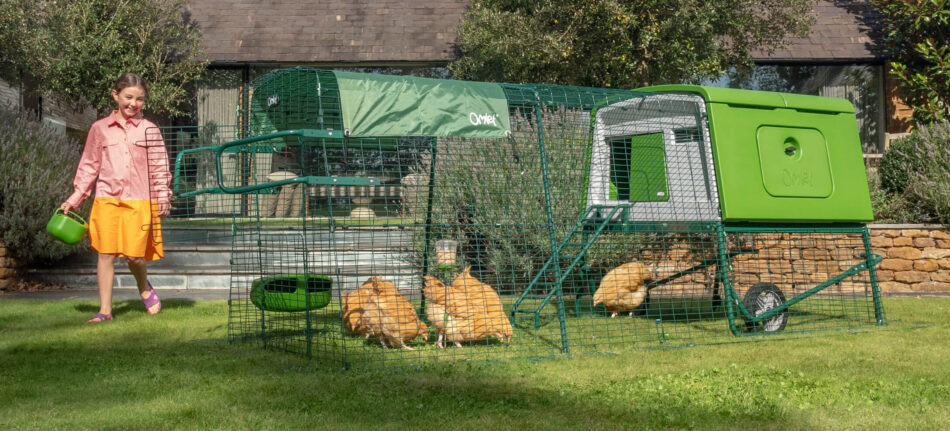
DIY vs ready-made chicken coops
Deciding whether to buy or build your first chicken coop? Building a proper chicken coop from scratch is hard – especially if you’re new to chickens. Hens have essentials when it comes to their home, and it’s hard for DIY plans to get them right. Most DIY plans look aesthetically pleasing, but leave much to be desired in functionality, safety, and practicality.
Omlet coops come as a kit to be assembled and have everything you need to get started with your flock right away. Our designs have been keeping hens healthy and happy for over a decade – so there’s no guesswork for you.
Choosing the perfect size coop for your flock
There’s a term that all chicken keepers will experience at some point: chicken math.
It’s used to describe the phenomenon of bringing home more chickens than you originally intended. This can occur right off the bat, or take a few months to set in, but at some point, most (if not all) chicken keepers crave more chickens.
That being said, it’s always best to get the biggest coop you can for your space and budget. Chickens thrive when as much space as possible is available to them, and extra space allows room for the inevitable chicken math conundrum.
What needs to be in your new chicken coop
A good chicken coop keeps hens comfortable, safe, and shielded from the elements – but a great chicken coop offers entertainment and enrichment as well. Chickens get bored if they don’t have enough stimulation, which can lead to behavioral and health issues. Be sure to offer a variety of things to keep your flock busy when they’re in their coop’s attached run. To bust boredom, try offering:
The more space and activities your hens have, the happier and healthier they’ll be. Some other ideas to keep boredom at bay include: serving fresh veggies in a Caddi Chicken Treat Holder, socializing with your flock, or moving a mobile chicken coop to fresh pecking grounds.
Top chicken coop care tips for new keepers
New chicken keepers should keep the following in mind when taking care of their chicken coops:
- Clean out your chickens’ coop daily to keep it fresh and to keep your hens’ in good health
- Use an odor-absorbing bedding such as pine pellets or shavings
- At least once a week, remove the roosting rack and droppings tray from your coop to pressure wash, or scrub with soap and water
- Collect eggs daily to help prevent broody hens and visits from predators
Keeping your chicken coop clean is one of the best ways to ensure that your hens are in a healthy atmosphere. Like most birds, chickens keep themselves clean through preening and dust bathing – but it’s up to their owners to keep up with their housekeeping.
Choosing a run your flock will love
Companion pieces to most chicken coops are chicken runs. Even if you want your hens to have access to most of your yard, there will inevitably be times that you’ll want to keep them penned up in a run. Large chicken runs give flocks that free-range feeling, without the hazards.
The best option for large spaces is a walk in chicken run. Not only does it maximize your chickens’ space, but it allows you to walk with your flock and get closer than ever to your hens. Omlet’s walk in chicken runs can also be extended at any time to accommodate a growing flock. Covers for walk in chicken runs can be added to give your flock shade from the sun or a barrier from snow, rain, and wind.
Other considerations when choosing your coop
Once you’ve researched and chosen the type of coop that best fits your lifestyle, you’ll also need to consider: chicken predators, the changing seasons, and zoning laws that may be applicable to you.
Predators
Omlet coops are designed to protect against chicken predators. The types of predators vary depending on your location, and you can bet that at some point they will come after your hens. Common chicken predators include:
- Raccoons
- Hawks
- Coyotes
- Foxes
- Snakes
- Neighborhood cats and dogs
Adding an automatic chicken coop door to your chickens’ coop adds an extra layer of protection against predators. The Autodoor ensures that your flock is safely closed into their coop each night, and the horizontal opening mechanism makes it extremely difficult for predators to pry open.
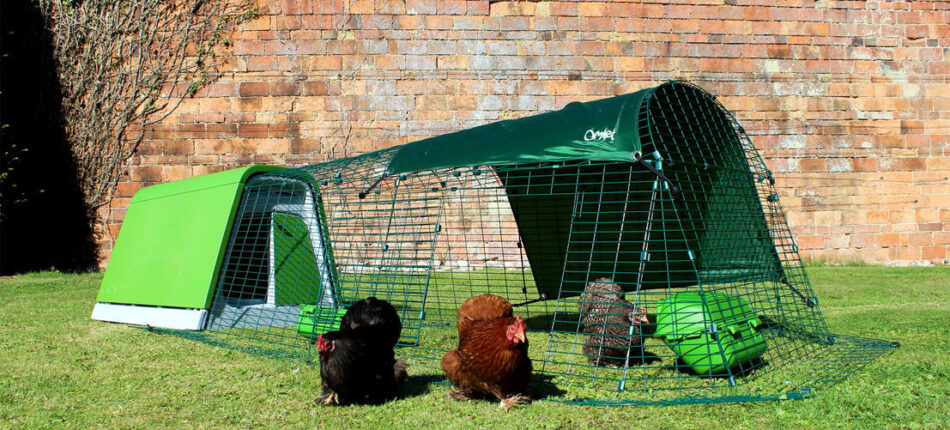
Seasons
Chickens are amazingly resilient, being built for life outdoors. However, not all breeds fare well in extreme temperatures. That’s why it’s so important to choose breeds that are suited to your location’s climate. Cold hardy breeds typically don’t fare well in the heat, while heat-tolerant breeds may struggle in the bitter cold. Aging hens may also not weather the changing seasons as they once did, and some minor coop modifications can go a long way in helping them through the extreme temperatures.
For areas that experience prolonged sub-freezing temperatures, an extreme temperature jacket can be added to your chickens’ coop as an extra layer of insulation. Weather protection for attached chicken runs in the form of tarps and covers can also be added to keep snow, rain, and wind off of your hens.
The same tarps and covers can also be used for hot weather conditions by providing shade on scorching days. Hens often do well in warm weather as long as they have adequate shade and water. You can also offer your hens frozen treats such as corn to help cool them off.
Zoning laws
Most states allow individual cities to decide if they will allow its citizens to keep chickens in their backyards. Many urban areas allow chickens, but you’ll need to contact your city’s zoning office to make sure before taking the plunge into poultry ownership. Homeowners associations (HOAs) may also have additional rules and regulations regarding chickens.
Zoning laws regarding chickens will often pertain to:
- How many chickens you can keep
- The size, type, and location of your chickens’ coop
- Roosters
HOA bylaws may differ from the city you live in. So, if you’re subject to an HOA, make sure you check with both the city and the HOA you reside in before purchasing your chicken coop.
Keeping chickens for the first time
Getting chickens for the first time is an exciting experience. But don’t forget that preparation goes a long way when getting ready to bring your flock home. Make sure you have the time, space, and supplies for your hens before committing to being a flock’s forever home. Some additional things to consider when keeping chickens:
- A safe, comfortable chicken coop
- Chicken run
- Perches
- Food
- Feeders and waterers
Make sure all of your equipment is assembled, and familiarize yourself with it before introducing your flock. You may find yourself wanting to make minor adjustments such as moving feeders and waterers or perches around, but the majority of your chickens’ set up should be well established by the time your hens come home.
Your first and last chicken coop with Omlet
Choosing your chicken coop is a commitment, but when the creators of the coop are as committed to chickens and their keepers as Omlet, you’re sure to have the best experience possible. And, don’t forget to have fun with your flock. Accessories for your chickens take flock-keeping to the next level, and chicken treats help you quickly bond with your hens.
When you choose Omlet for your chickens’ coop and accessories, you’re not just purchasing your first coop – it’s the only coop you’ll ever have to buy. Unless of course you fall victim to chicken math and need more chicken coops. Don’t say we didn’t warn you!


This entry was posted in Chickens















































